Pilot Pentland Firth and Orkney Waters Marine Spatial Plan - Regional Locational Guidance
This Regional Locational Guidance collates information from a wide variety of sources to assist the wind, wave and tidal energy developers in situating their developments.
4 Sectoral Information
4.1 Aquaculture
4.1.1 In 2013, the marine aquaculture industry in the North Region had 104 full-time and 8 part-time staff (Marine Scotland, 2014a; Marine Scotland, 2014b; personal communication (2 nd December 2014).
4.1.2 Active sites are those that have produced finfish or shellfish in the last three years or are fallow as part of a production process [7] Within the PFOW MSP area in 2013 there were 17 active shellfish sites, 6 in Orkney and 10 on the north coast, most of these are situated in Loch Eriboll with one in the Kyle of Tongue. There were 20 and 2 active finfish farm sites in Orkney and on the north coast respectively (Marine Scotland, 2014a).
4.1.3 The Scottish Shellfish Farm Production Survey 2013 (Marine Scotland, 2014b) notes that there was no production from the Orkney sites with three businesses currently on-growing mussels. The survey does not have specific information for the north coast alone as this area is included in the Highland region and includes sites along the west coast. The 10 north coast sites as seen in Scotland's aquaculture website are included in the 71 active shellfish sites for the Highland Region. Figure 7 shows the active aquaculture farms for finfish and shellfish in the PFOW area.
4.1.4 There are no several orders in the PFOW area. A several order gives its grantee an exclusive right to deposit, propagate, dredge, fish for or take the species named in the Order, in the specified area and for a specified limit of time. An order may restrict other fishing practices within its area in order to protect the specified shellfish stock (Marine Scotland, 2014b).
4.1.5 The Scottish Government has introduced a package of measures to ensure the continued protection and improvement of shellfish growing waters by integrating designated shellfish protection areas within the river basin management planning process. Figure 7 also shows these protected waters for shellfish growing [8] .
Figure 7: Aquaculture farms and shellfish growing waters in the PFOW area.
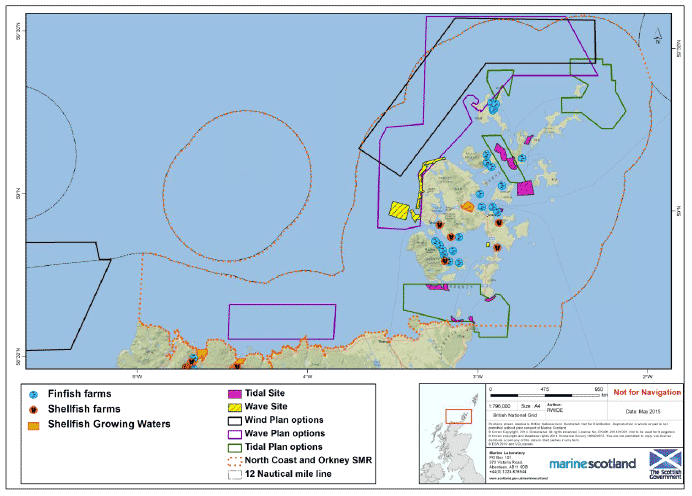
4.2 Aviation
4.2.1 Airports in the PFOW area includes the airports of Kirkwall in Orkney and Wick-John O'Groats just outside the area. There are also a number of smaller airfields located on the Orkney Islands at Eday, North Ronaldsay, Papa Westray, Sanday, Stronsay and Westray [9] .
4.2.2 Figure 8 shows the known aviation activities taking place in relation the PFOW PO areas.
4.2.3 The Civil Aviation Authority provides the buffer zones to be taken into account for active aerodromes. Two of these overlap with TN3, one with TN4 and two, including the suggested buffer of Kirkwall airport, with TN2. It is not presumed that these buffer zones will generate constraint within these tidal POs.
4.2.4 The radar buffer zones have been provided by the National Air Traffic Services ( NATS) which provide guidance, known as self-assessment maps, that show the possible radar interference with NATS en Route Licence ( NERL) equipment that could be generated by wind turbines [10] . These spatial information data should be taken as a recommendation to help recognize potential radar interference from offshore wind farms. The extent of the self-assessment maps does not overlap with any of the POs in the PFOW area and is limited to the south east of the PFOW area. Figure 8 shows the aviation concerns and safety buffer extents that will have to be considered in the PFOW area.
Figure 8: Aviation in the PFOW area.
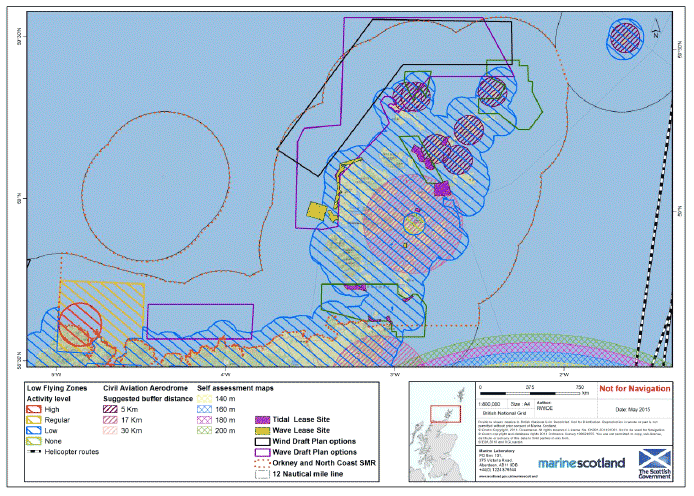
4.3 Bathymetry and seabed
4.3.1 The bathymetry and seabed characteristics of the PFOW area are shown in Figures 9- 12. These data were derived from the Marine Themes digital elevation model ( DEM) available from the Oceanwise marine GIS data set [11] as provided under commercial licence to Marine Scotland. Information on this bathymetry layer is available at the Oceanwise website. Other references to depths in this report have also been extracted from this dataset.
4.3.2 An isobath (contour lines connecting areas of equal depth) layer is also included in Figure 9. This layer provides depth contour lines and depth labels and is also available from the Oceanwise marine GIS data set.
4.3.3 A seabed sediment information layer generated by the British Geological Society ( BGS) has been used to illustrate what types of sediments can be found in the seabed around the PFOW area ( BGS, 1995). Figure 10 shows the variety of sediments likely to be encountered. The map is based on sea-bed grab samples of the top 0.1 m of sediment, combined with cores and dredge samples as available. A standard Folk triangle classification has been used based on the gravel percentage and the sand to mud ratio [12] .
4.3.4 Predictive habitat maps have been created as part of the Mapping European Seabed Habitats ( MESH) project using the European Nature Information System ( EUNIS) classification system ( EMODnet, 2012). This classification combines seabed sediment, bathymetry, topography and other physical conditions with biological and habitat information and can allow the development of predictive techniques to fill gaps in our knowledge of seabed biotopes and dominant biota. The gathering and analyses of the survey data upon which these classifications are based is done by the Joint Nature Conservation Committee ( JNCC). See Figure 11 for the predicted habitats map. The methodology for the creation of these habitat classifications and list of full classifications is available at the MESH website [13] .
4.3.5 Spatial information is available that determines the level of energy on the UK seabed area. This information has been used in Figure 13 and is taken from the Joint Nature Conservation Committee UKSeaMap 2010 GIS layer (McBreen, 2011). The Pentland Firth ( TN1) and the other tidal areas ( TN2- TN4) are high energy environments. It is this energy that the tidal developments will seek to extract.
Figure 9: Bathymetry of the PFOW area.
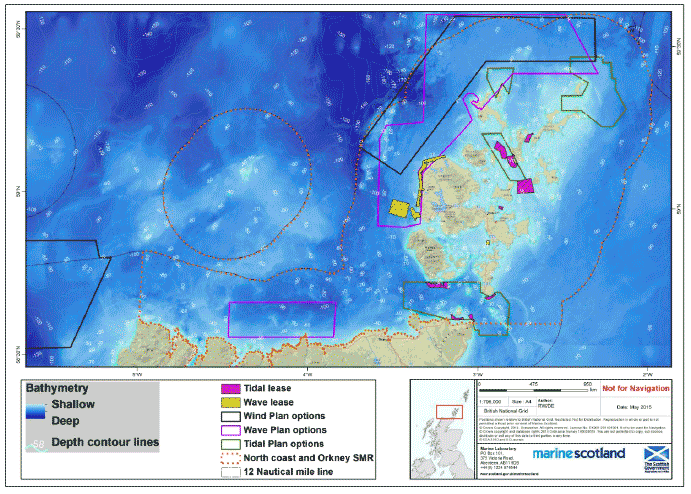
Figure 10: Seabed sediment types in the PFOW area.
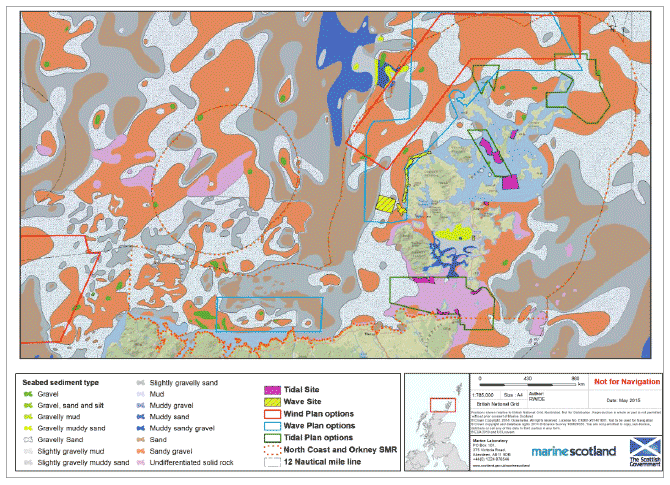
Figure 11: Predicted habitats in the PFOW area.
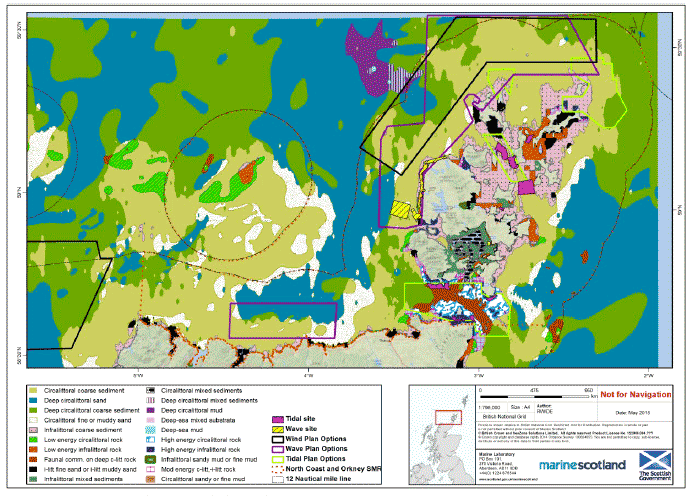
Figure 12: Predicted energy in submerged environment in the PFOW area.
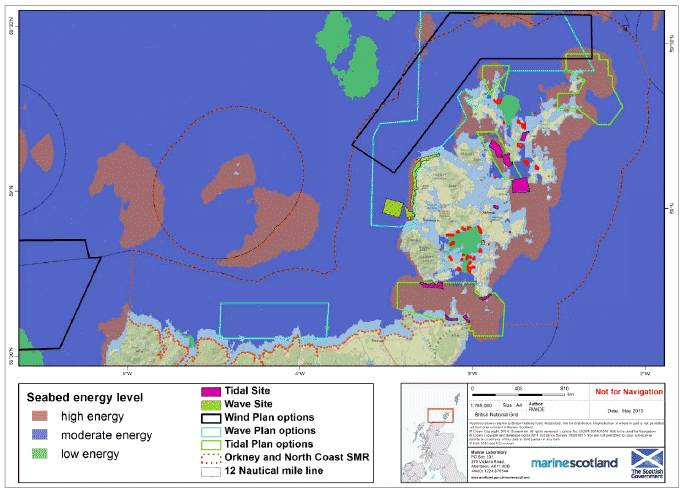
4.3.6 The following sections provide more detailed information on bathymetry and the seabed characteristics for each of the POs.
Wind - North of Orkney ( OWN1)
4.3.7 Depths within OWN1 vary from 30-100 m according to the Oceanwise bathymetry data layer; the deeper parts are found at the south western part of the area.
4.3.8 The sediments in OWN1 are mostly of the gravelly sand variety as described in the BGS bottom sediment dataset. The EUNIS ( EMODnet, 2012) data describes this habitat as being composed predominantly of circalittoral coarse sediment and similar habitats. The seabed energy level at this PO is described as moderate.
Wave - North Sutherland Coast ( WN1)
4.3.9 Depths within the North Sutherland Coast PO area ( WN1) vary from 17 m around Strathy Point to 118 m towards the northeast part of this PO area. The average depth is 70 m.
4.3.10 The sediments in the Sutherland WN1 area are a mix of variations of sandy gravel as described in BGS bottom sediment dataset. The EUNIS data ( EMODnet, 2012) for WN1 describes this habitat as being composed of predominantly deep circalittoral sand and coarse sediment. The seabed energy level at this PO is described as moderate.
Wave - North and West of Orkney ( WN2)
4.3.11 Depths within the Orkney PO area ( WN2) vary from 132 m in the northwest corner to less than 10 m in areas close to the coast.
4.3.12 Sediments in the North and West of Orkney WN2 area are predominantly sandy gravel and gravelly sand. The EUNIS data for WN2 describes this habitat as being composed predominantly of circalittoral coarse sediment with some areas of circalittoral deep coarse sediment, and a small patch of circalittoral sand sediment. The seabed energy level at this site is described mostly as moderate with patches of higher energy to the north and the north east parts.
Tidal - Pentland Firth ( TN1)
4.3.13 Depths within the Pentland Firth vary from 20 m to 96 m, with an average depth around 60 m; the western part of the area is deeper and the central area south of Stroma is the shallowest part.
4.3.14 The sediment type in the Pentland Firth comprises a central mass of undifferentiated rock bordered on the west by gravelly sand and on the east by sandy gravel as described in the BGS bottom sediment dataset. The EUNIS data ( EMODnet, 2012) describes this habitat as being composed predominantly of faunal communities on deep moderate energy circalittoral rock running through the central part east to west surrounded by high energy circalittoral rock with some deep circalittoral coarse sediment to the east and west. Given that these POs were selected by using a tidal speed threshold it is expected that they will inhabit an area of high seabed energy level as this is what is to be harnessed by developments in these areas.
Tidal - Orkney, Westray and North East Sanday ( TN2 - TN4)
4.3.15 Water depths within Orkney and Westray are shallower as these sites lie closer to land. The range of depths within these sites goes from as little at 5 m in Rousay and mainland up to 70 m in the northern parts of the PO area.
4.3.16 The seabed map around Orkney does not cover fully the most inland parts of the PO area but in areas of coverage seabed sediments show predominantly sandy gravel or gravelly sand. This is corroborated with the predicted EUNIS database, which cites the area as comprising coarse sediment or high energy infralittoral rock. The seabed energy level, as expected, is described as high for most of the extent of these POs.
4.4 Cultural heritage
4.4.1 Figure 13 shows that the region includes numerous wreck sites. Of greatest importance are the remains of ships from the German High Seas Fleet in Scapa Flow. These seven wrecks are scheduled monuments, and have been extensively mapped and documented [14] . A voluntary underwater conservation zone for the Scapa Flow area has been put in place by the Orkney Dive Boat Operators Association and Orkney Heritage (Historic Scotland, 2009).This voluntary scheme provides a code of conduct for recreational divers around Orkney's submerged historical heritage.
4.4.2 Any activities or developments which could impact on the scheduled monuments require consent from Historic Scotland. These scheduled monument areas are, however, not within or immediately adjacent to the PO areas.
4.4.3 The area of coast to the north and west of Orkney is close to extensive areas that have potential for submerged archaeology, as seen in Figure 13. The layer used has been developed by Marine Scotland to provide an overview of where submerged archaeology may be found and is based upon outputs from Goodwyn et al. (2010).
4.4.4 The Heart of Neolithic Orkney World Heritage Site and its buffer zone covers an extensive area on the west coast of Orkney which includes the Mainland Island and the Island of Hoy (Historic Scotland, 2014). A World Heritage site is a place that is listed by the United Nations Educational, Scientific and Cultural Organization ( UNESCO) as of special cultural or physical significance [15] .The Site is managed and cared for by Historic Scotland on behalf of Scottish Ministers. The Management Plan guides sustainable management to maintain the Outstanding Universal Value (Historic Scotland, 2014).
4.4.5 The numerous listed buildings and scheduled monuments around the Orkney coast include lighthouses, cairns, chapels and dwellings, with varying levels of listing and importance (Marine Scotland, 2013). Further information can be found on PastMap, an interactive mapping tool that combines information from architectural, archaeological, industrial and maritime sites throughout Scotland from Canmore the Royal Commission on the Ancient and Historical Monuments of Scotland ( RCAHMS) database of Scotland's monuments [16] .
4.4.6 The statutory role undertaken by Historic Scotland on behalf of Scottish Ministers in the marine environment now includes protection and management of heritage sites of national importance, provision of heritage advice to Marine Scotland on the new marine planning system, and environmental assessment of impacts to archaeological sites in the marine environment [17] .
4.4.7 Project Adair was initiated in July 2011 as a partnership between Historic Scotland and RCAHMS. The project sought to improve the record of the marine historic environment in a cost effective way and to ensure information is efficiently and effectively disseminated by integrating the existing sources of information on marine heritage, thereby underpinning Scottish Ministers' policies for encouraging sustainable economic growth in the coasts and seas around Scotland through implementation of the Marine (Scotland) Act and UK Marine and Coastal Access Act 2009 ( RCAHMS, 2013). The outputs from Project Adair are also available to view through the Canmore PastMap interactive mapping tool. Figure 13 shows the locations of the protected wreck sites which lie within Orkney and also in open water to the east and the west, north of Cape Wrath. These sites are populated by vessels that have been designated as protected places or controlled sites under the protection of military remains Act 1986. The sunken vessels that form a cluster within Scapa Flow and include the wrecks of seven German warships are also classed as scheduled ancient monuments ( RCAHMS, 2013).
Figure 13: Cultural heritage interests in the PFOW area.
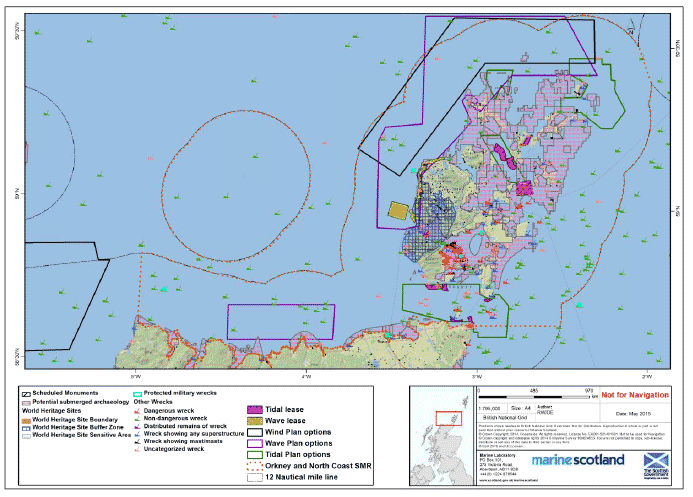
4.5 Defence
4.5.1 The coastal military locations which occur within this region are shown in Figure 14. The Defence theme in the Oceanwise database contains data from the United Kingdom Hydrographic Office ( UKHO) which describes the locations of marine military practice [18] . Military interests in this region include the Cape Wrath official gunnery and bombing range, mainly used for live gunnery practice by the Royal Navy and allied navies and for live bombing practice by the RAF and the Fleet Air Arm ( FAA); and a 'firing danger' and 'other' exercise area to the East of Orkney. These data are accessible to Marine Scotland through the Oceanwise Marine Theme Administrative layer under licence.
4.5.2 From the Oceanwise spatial database layers on military practice areas we can see that the wave PO areas WN1, in its entirety, and WN2 at its southern tip as well as the tidal PO area TN1 overlap with the Northern Managed Danger Area ( MDA). MDAs are danger areas established for air combat manoeuvre training within which activity is managed by the Military [19] .
4.5.3 The Northern MDA is classed as medium risk level according to the classification agreed upon between the Crown Estate and the Ministry of defence ( MOD) for these military practice and exercise areas. The military practice areas and coastal defence installations can be seen in Figure 14.
Figure 14: Military practice activities in the PFOW area.
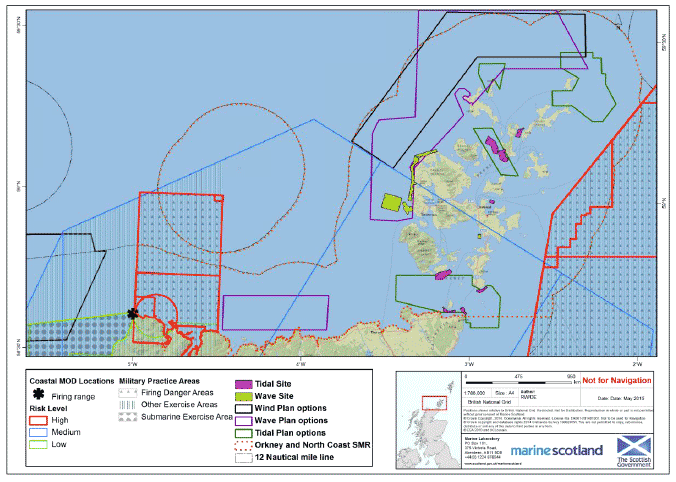
4.6.1 The PFOW MSP area has a wealth of natural designated sites as shown in Figure 15. In and around the PO areas there are a number of important international designations, which are detailed in Table 2.
4.6.2 The natural designations included in the table are those that are located in the PFOW MSP area as delimited in Figure 15 and includes one Special Protection Area ( SPA) and Ramsar site that extends to 70 km inland in the case of the Caithness and Sutherland peatlands as these are taken as a unit that starts at the north coast. The remainder of the natural designations are predominantly coastal. SPA sites overlap with the Ramsar sites on land as the initial emphasis was on selecting sites of importance to waterbirds within the UK, and consequently many Ramsar sites are also SPAs classified under the Birds Directive ( JNCC, 2014a).
4.6.3 As well as the established SPA with marine components, offshore SPAs are in the process of being identified. Figure 15 shows the potential offshore SPAs for concentration of seabirds at sea. The European Seabirds at Sea ( ESAS) seabird database has been analysed to identify offshore aggregations and begin the process of identifying the most appropriate locations to establish SPA for the protection of offshore seabird populations (Kober et al., 2012).
4.6.4 The Marine (Scotland) Act in 2010 delivered new powers to protect habitats and species of national and international importance through the designation of Marine Protected Areas ( MPAs). Following the consideration of search areas a range of proposed MPAs ( pMPAs) were identified around the Scottish coast. In 2014 these were adopted and now form part of the UK MPA network. Figure 15 shows the distribution of these newly appointed MPAs in the PFOW area. Three MPA are found within the extent of the PFOW area with the West Shetland MPA further offshore to the northwest.
4.6.5 In the PFOW MSP area, the MPAs and their biodiversity features of interest, include (Marine Scotland, 2012a):
- North West Orkney: Sandeels
- Papa Westray: Black guillemot
- Wyre and Rousay Sounds: Kelp and seaweed communities and maerl beds
4.6.6 One offshore SAC to the west of Sule Skerry and Sule Sgeir has been designated to protect stony reefs.
Figure 15: Marine natural designations in the PFOW area.
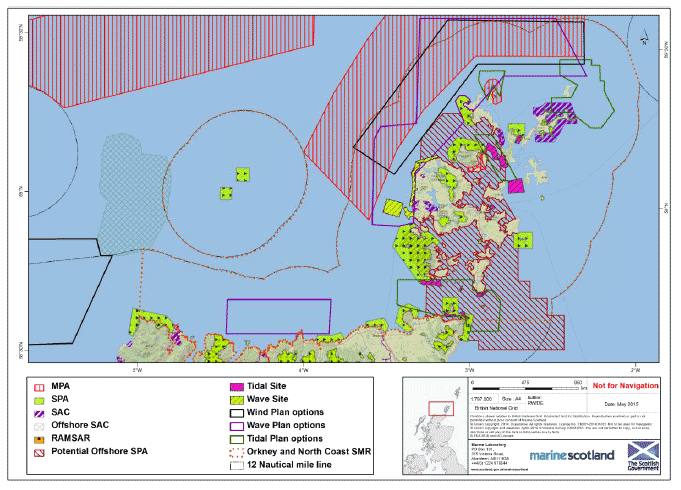
Table 2. International designated sites in the vicinity of the PFOW area.
| Designation | Name | Area (Ha ) |
Reason for Designation |
|---|---|---|---|
| Special Area for Conservation ( SAC) |
Hoy | 9500 | Heaths, fens, blanket bog, sea-cliff habitats |
| Stromness Heaths and Coast |
638 | Heaths, fens, sea-cliff habitats | |
| Sanday | 10972 | Reefs, subtidal sandbanks, intertidal mudflats, sandflats, harbour seals | |
| Faray and Holm of Faray |
786 | Grey seals | |
| Caithness and Sutherland Peatlands |
143572 | Reasons include: blanket bog, peat habitats, wet mires, heathland, water features | |
| Cape Wrath |
1015 | Coastal sand dunes, Sandbeaches, Machair Shingle, Sea cliffs, Islets |
|
| Broubster Leans |
173 | Bogs, Marshes, Water fringed vegetation, Fens, Dry grassland, Steppes | |
| Durness | 1213 | Coastal sand dunes, Sand beaches, Machair, Shingle, Sea cliffs, Islets |
|
| Fair Isle | 561 | Shingle, Sea cliffs, Islets Inland water bodies Bogs, Marshes, Water fringed vegetation, Fens Heath |
|
| Invernaver | 295 | Grey dunes, Atlantic decalcified dunes, coastal dunes with Juniperus spp. | |
| Loch of Isbister | 105 | Inland water bodies Bogs, Marshes, Water fringed vegetation, |
|
| Loch of Stenness | 792 | Tidal rivers, Estuaries, Mud flats, Sand flats, Lagoons | |
| River Borgie | 34 | Freshwater pearl mussel, Atlantic salmon, Otter | |
| River Thurso | 353 | Atlantic salmon,Bogs, Marshes, Water fringed vegetation, Fens | |
| Strathy Point | 204 | Vegetated sea cliffs of the Atlantic and Baltic Coasts, Shingle, Sea cliffs, Islets | |
| Special Protection Area ( SPA) | Hoy | 18122 | Breeding Bird Interests |
| Marwick Head | 476 | Breeding Bird Interests | |
| Rousay | 5483 | Breeding Bird Interests | |
| West of Westray | 3781 | Breeding Bird Interests | |
| Papa Westray | 246 | Breeding Bird Interests | |
| East of Sanday | 1515 | Breeding Bird Interests | |
| Calf of Eday | 2669 | Breeding Bird Interests | |
| Auskery | 102 | Breeding Bird Interests | |
| Copinsay | 3608 | Breeding Bird Interests | |
| Caithness and Sutherland Peatlands | 145517 | Breeding Bird Interests | |
| North Sutherland Coastal Islands | 221 | Breeding Bird Interests | |
| North Caithness Cliffs | 14621 | Breeding Bird Interests | |
| Cape Wrath | 6737 | Breeding Bird Interests | |
| Orkney Mainland Moors | 5342 | Breeding Bird Interests | |
| Sule Skerry and Sule Stack | 3909 | Breeding Bird Interests | |
| Switha | 57 | Breeding Bird Interests | |
| Ramsar | East of Sanday | 1515 | Same reasons as for SPA |
| Caithness and Sutherland Peatlands | 143503 | Same reasons as for SPA | |
| Caithness lochs | 285491 | Same reasons as for SPA |
4.6.7 In addition, as provided by the Scottish Natural Heritage ( SNH) website there are a range of coastal Sites of Special Scientific Interest ( SSSIs) [20] that may influence the future development of offshore wind power around Orkney and Caithness and Sutherland. SSSI boundaries in some instances match the boundary of international designations. A list of the SSSIs found in the area and their key interest features is provided in Table 3 below and Figure 16 shows the location of the SSSI in the PFOW area as well as the existing non-statutory designations: the marine consultation area in Loch Eriboll, (Highland Council, 2000) and the local nature reserve at Mull Head, (Orkney Islands Council, 2014).
Table 3. SSSIs in the vicinity of the PFOW area.
| Site Name | Reason For Designation |
|---|---|
| Auskerry | Breeding bird interests |
| Calf of Eday | Breeding bird interests |
| Cape Wrath | Breeding bird interests |
| Central Sanday | Saltmarsh, sand dune, machair |
| Copinsay | Breeding bird interests |
| Doomy and Whitemaw Hill | Breeding bird interests |
| Duncansby Head | Breeding bird interests |
| Dunnet Head | Breeding bird interests |
| Dunnet Links | Sand dune habitats |
| Durness | Sand dune, maritime cliff habitats |
| East of Sanday Coast | Non-breeding birds, harbour seals, vascular plant interests, rocky shore and sand flats |
| Eilean Hoan | Breeding bird interests |
| Eynhallow | Harbour seals |
| Faray and Holm of Faray | Grey seal |
| Holm of Papa Westray | Breeding bird interests |
| Hoy | Breeding bird interests |
| Marwick Head | Breeding bird interests |
| Muckle and Little Green Holm | Grey seal |
| North Hill | Breeding bird interests, maritime cliff habitat |
| Pentland Firth Islands | Breeding bird interests, vascular plant assemblages |
| Red Point Coast | Breeding bird interests, maritime cliff habitat |
| Rousay | Breeding bird interests |
| Strathy Coast | Saltmarsh, sand dune, machair, maritime cliff habitats |
| Stroma | Breeding bird interests |
| Stromness Heaths and Coast | Heath, cliff habitats |
| Ushet Head | Maritime cliff habitat |
| Ward Hill Cliffs | Maritime cliff habitat |
| West of Westray | Breeding bird interests |
Figure 16: Sites of Special Scientific Interest and non-statutory designated sites in the PFOW area.
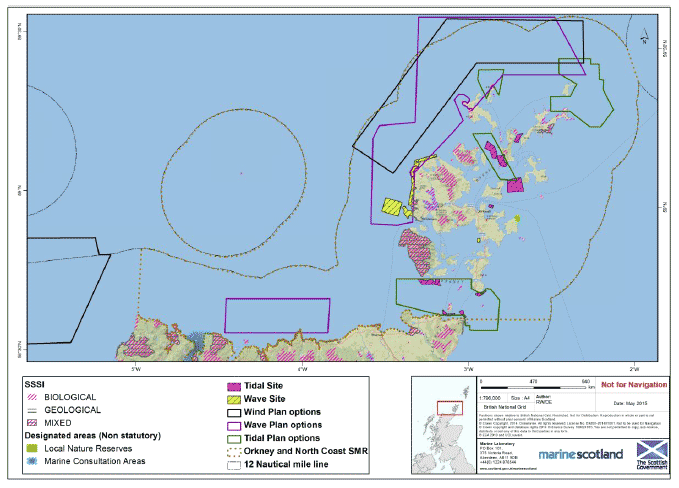
8.7 Marine mammals
4.7.1 The overall cetacean encounter per standard hour has been calculated from the data available on cetacean encounter rates as provided by the JNCC cetacean atlas information (Reid et al., 2003). These data allow the overall number of encounters for the cetacean species observed in Scottish waters to be calculated. The spatial resolution of this data set is a quarter of a statistical rectangle (approximately 800 km 2 in the PFOW area).
4.7.2 The encounter numbers per standard hour has been expressed for Scottish waters only. The map output in Figure 17 shows the sum of the proportions of each species' population in each grid square. For example: in any one grid square the encounters per standard hour have been divided by the total amount of encounters of that species in Scottish waters, the numbers expressed are the sum of these multiplied by 1000.
4.7.3 Table 5 gives a comparison of the summed proportional encounter rates for the general PFOW area (bounded by the box within latitudes and longitudes in decimalised degrees (in WGS 84): 59.625, -5.75; 58.375,-5.25; 59.625,-1.75; 58.625,-1.75) and the whole of the Scottish waters cetacean encounter rates as taken from the datasets available from the JNCC Cetacean Atlas (Reid et al., 2003). This table offers a simple comparison of overall rates of encounter between the PFOW area extent and all of Scottish waters. Further analysis would have to be undertaken to investigate these differences on a species basis and on a higher resolution spatial scale.
Table 4. Summary of summed cetacean encounters in Scottish territorial waters and in the PFOW area. All cetaceans encounters taken from the Cetacean Atlas, (Reid et al., 2003). These show encounters per standard hour and have been multiplied by 1000 to reduce the decimal spaces in the figures.
| Cetacean encounters per standard hour x1000 | |||
| mean | maximum | minimum | |
|---|---|---|---|
| PFOW | 10.66 | 67.73 | 0 |
| Scottish waters | 22.36 | 869.75 | 0 |
Figure 17: Cetacean encounters per hour in the PFOW area.
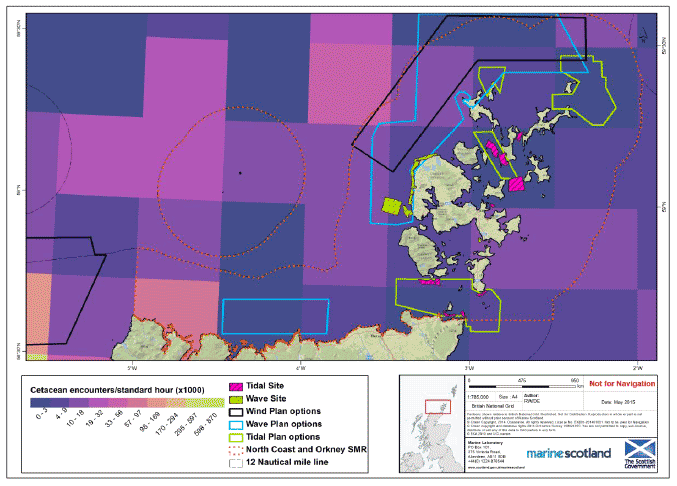
4.7.4 Seals will also be an important consideration given the sensitivity of some of the resident populations such as harbour seals. An index of the mortality that can be tolerated from a population basis called the potential biological removal ( PBR) has been used to estimate how many individuals can be safely removed from the population (Sea Mammal Research Unit ( SMRU), 2013).
4.7.5 Seal haul-out sites have recently been updated to reflect the latest knowledge and data gathered by the Sea Mammal Research Unit ( SMRU) on behalf of Natural Environmental Research Centre ( NERC). These haul-out sites have been designated to provide additional protection for seals from intentional or reckless harassment [21] .
4.7.6 Marine Scotland has also collaborated with the SMRU in St. Andrews, Scotland to generate density maps that show where grey and harbour seals can be found more frequently and to allow an assessment of the usage of the sea area around the PFOW area by these two species. These maps are created using individually tagged seal movement tracks, which are then raised to a population level by applying data gathered on seal distribution derived from aerial surveys. Figures 18 and 19 below show the density of seal usage at sea as well as the PBR and the haul-out sites for grey and harbour seals in the PFOW area .
4.7.7 Outputs from the seal at sea usage maps reveal that PO TN1 will require particular attention for both Grey seals and Harbour seals as for both these species that area is of moderate to high usage. Harbour seals will require particular monitoring given their low PBR. Grey seals can also be expected to be encountered at TN2 in high numbers and TN3 and TN4 in slightly fewer numbers. Harbour seal populations will have to be monitored carefully throughout the whole of the Orkney Islands and Pentland Firth.
Figure 18: Grey seal sea usage in the PFOW area .
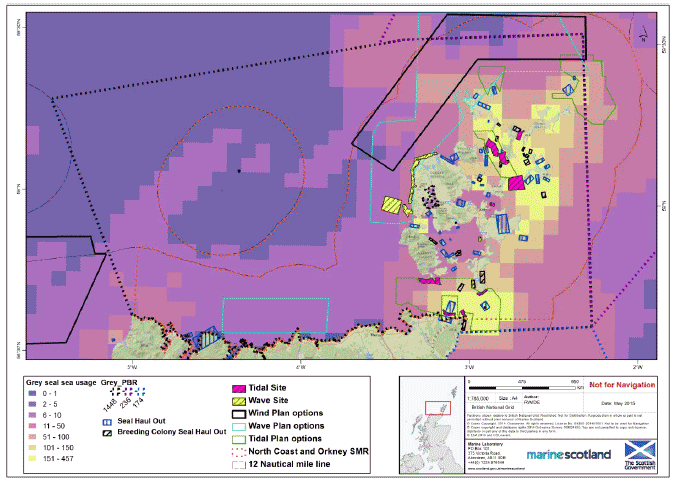
Figure 19: Harbour seal sea usage in the PFOW area.
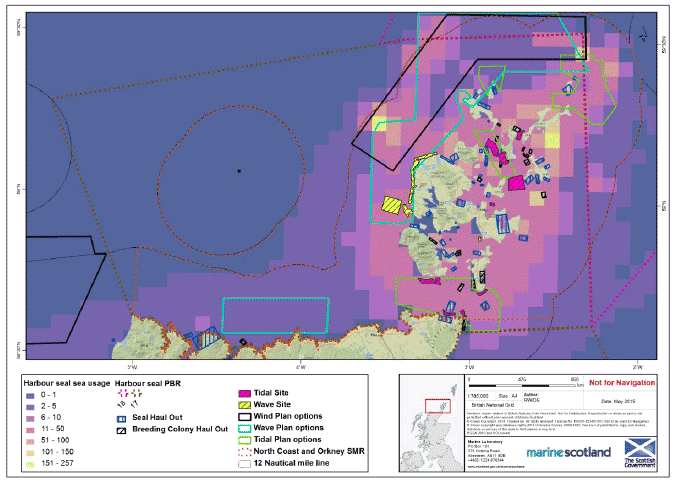
4.8 Basking sharks
4.8.1 Recorded sightings of basking sharks around the north of Scotland and Orkney come from many sources, including the Sea Watch database of casual sightings and systematic observations, Marine Conservation Society ( MCS) database of shark records for Scotland, Orkney Biodiversity Records ( OBR) database and EMEC land-based watches from two Orkney renewable device test sites (Evans et al., 2011).
4.8.2 Basking sharks have been shown to present high densities around the west coast of Scotland and south west of England (Southall et al.,2005, Speedie et al., 2009), expected densities are lower in the PFOW area but basking sharks have been sighted through the years, and as such these animals will have to be considered in the context of offshore developments.
4.8.3 No known areas of high basking shark density exist around the wind, wave or tidal PO areas in the PFOW area although some sightings have been recorded since systematic surveying started to inform the build of the EMEC marine energy test centre (Evans et al., 2011), see Figure 20 for the year of sightings and the numbers seen at any one sighting location.
4.8.4 According to SNH basking shark records (Evans et al., 2011) individuals seen from North Scotland and Orkney land bases are widely scattered with no particular concentration. They have occurred in most months of the year, although rarely between November and April. Peak records occur between July and September (particularly August). Other research found a similar pattern along the west coast of Scotland (Speedie et al., 2009; Sea Watch, unpublished data). Figure 20 below shows the sightings in the last two decades around the PFOW MSP area.
Figure 20: Basking shark sightings.
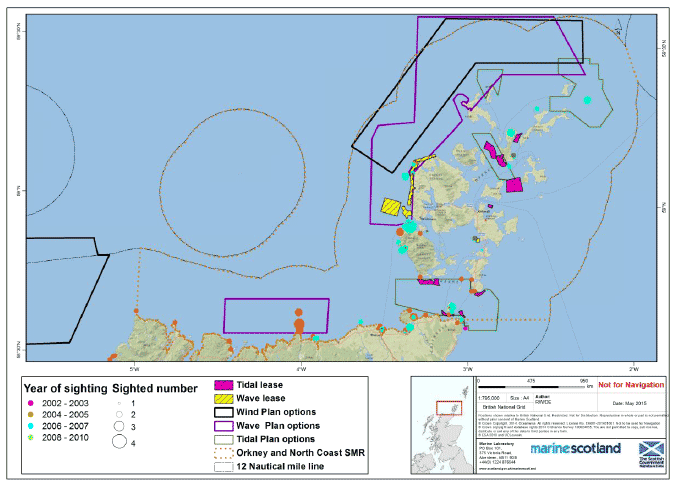
4.9 Seabirds
4.9.1 There are six Special Protection Areas ( SPA) in Orkney. The SPA at west Westray is the closest to OWN1 and the cliffs support large colonies of breeding auks and kittiwake, whilst the grassland and heathland areas support breeding colonies of skuas and terns. The seabirds feed in the surrounding waters outside the SPA. Another two SPAs can be found at Calf of Eday on the East Sanday coast between these two sites there are colonies of gulls, cormorants fulmars kittywakes and auks as well as wintering waders ( JNCC, 2014a).
4.9.2 SPAs also exist further south at Copinsay, Marwick Head, Rousay and Hoy. The seabirds from these SPAs feed around the surrounding waters ( JNCC, 2014a).
4.9.3 Offshore draft SPAs are in the process of being identified by JNCC and SNH, these, still in draft stage, additions to the seabird protection network have been covered in this report in section 4.6.3.
4.9.4 Eleven Royal Society for the Protection of Birds ( RSPB) reserves have been created in Orkney, from Hoy in the south to North Hill in the north and Copinsay in the east. The numbers of seabirds at sea inside the around Orkney are low to moderate. However, it can be anticipated that any proposal for offshore wind development will have to give consideration to interactions with the highly varied and numerous seabird and waterbird species, both resident and passage populations in the general area.
4.9.5 Important Bird Areas ( IBA) have also been established to protect the sensitive Orkney populations. The largest two are in Hoy, where up to 56,000 breeding pairs return regularly and in the mainland near Scapa Flow to protect waterbirds like red necked grebes and eider ducks. IBAs have been established in all the Orkney islands [22] .
4.9.6 The EUROPEAN Seabirds at Sea ( ESAS) database is curated by JNCC and is based on observations and measurements of seabirds at sea. Data on seabirds at sea has been collected from boat and aerial surveys since 1980 (Kober, et al., 2010).
4.9.7 Vulnerability indices calculated in Furness and Wade (2012a) and Furness and Wade (2012b) were applied to the ESAs seabird density data sets. These indices use a combination of biological and behavioural aspects for each seabird species to create an overall level of vulnerability per species. The Furness study was carried out to investigate the effects of wind turbines both for collision and displacement and for collision vulnerabilities to tidal and wave devices.
4.9.8 The maps that describe the seabird relative vulnerabilities were created by combining interpolated data from the European seabird at sea ( ESAS) database and joining it into a 6x6 km grid which allowed the grid to be classified according to the varying overall densities. Maps were created for vulnerabilities specific to wind, wave and tidal energy devices for breeding and for winter data sets. The two vulnerabilities represented are collision and disturbance. Figures 21 to 28 show the varying vulnerabilities for collision and displacement calculated using the breeding and the winter ESAS data sets.
4.9.9 Table 5 compares the overall densities of seabird species available in the ESAS dataset in the PFOW area (bounded by the box within latitudes and longitudes (in WGS84): 59.62, -5.25; 58.625,-5.25; 59.625,-1.25; 58.625,-1.25) with the densities of the whole extent of Scottish waters.
Table 5. Summary of summed densities (all species in ESAS breeding dataset, per grid square) recorded within Scottish territorial waters and those only recorded within the PFOW extent.
| mean | maximum | minimum | |
|---|---|---|---|
| PFOW | 213 | 5908 | 0 |
| Scottish waters | 118 | 14828 | 0 |
Figure 21: Seabird vulnerability index to collision with offshore wind devices during the breeding season.
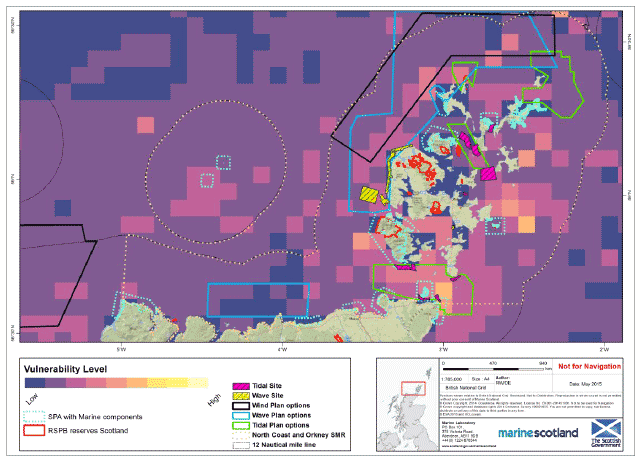
Figure 22: Seabird vulnerability index to collision with offshore wind devices during the winter season in the PFOW area.
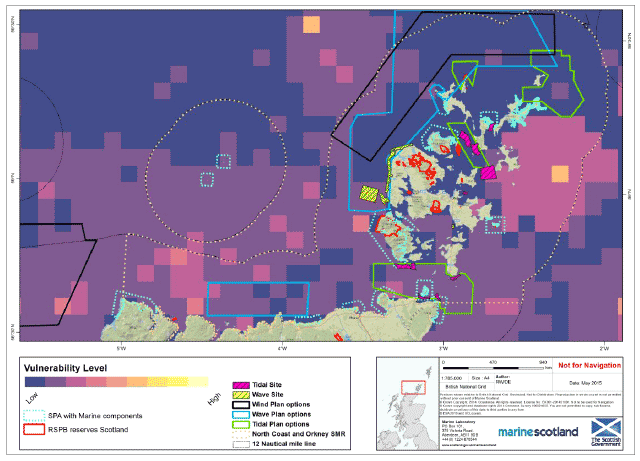
Figure 23: Seabird vulnerability index to displacement due to offshore wind turbines during the breeding season in the PFOW area.
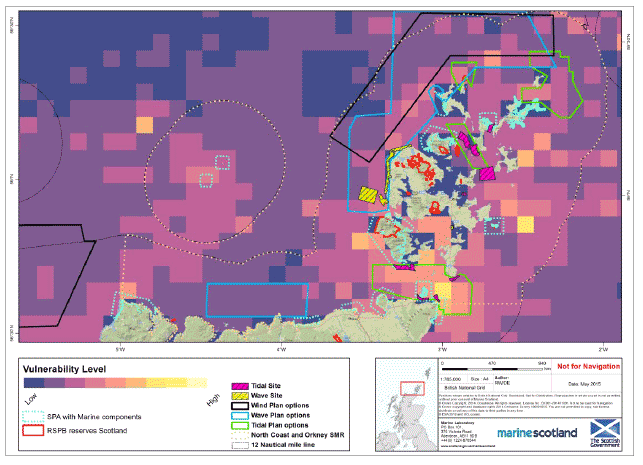
Figure 24: Seabird vulnerability index to displacement due to offshore wind turbines during the winter season in the PFOW area.
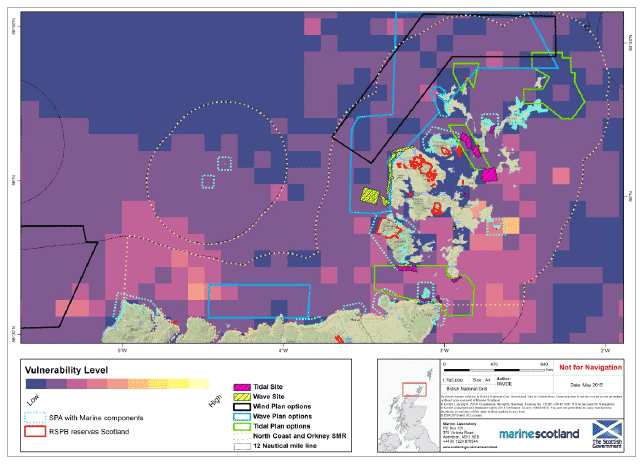
Figure 25: Seabird vulnerability index to collision with wave devices during the breeding season in the PFOW area.
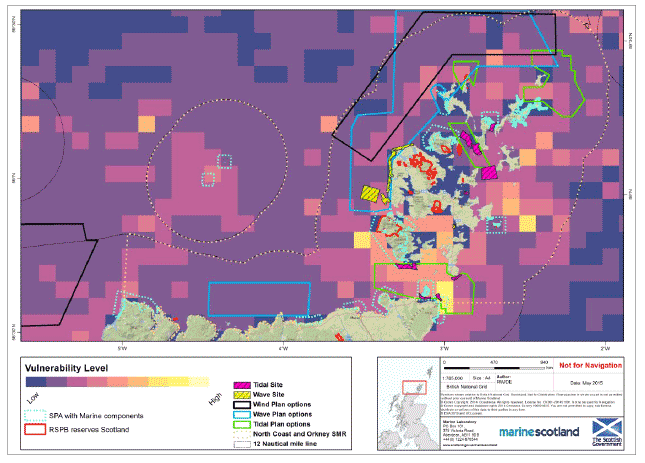
Figure 26: Seabird vulnerability index to collision with wave devices during the winter season in the PFOW area.
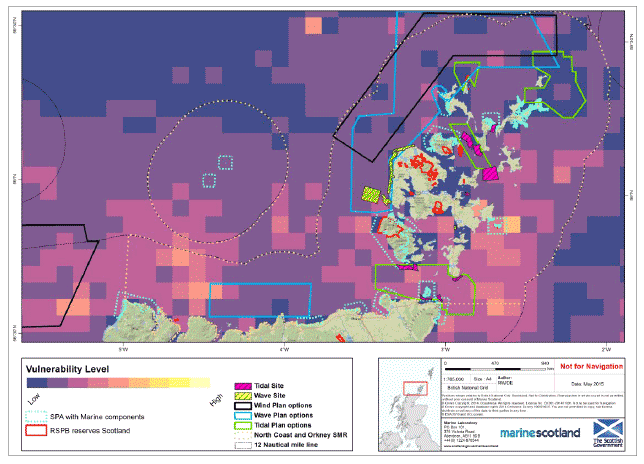
Figure 27: Seabird vulnerability index to collision with tidal devices during the breeding season in the PFOW area.
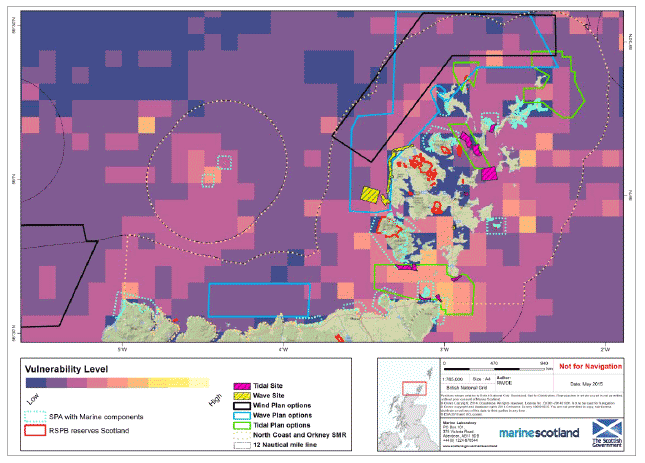
Figure 28: Seabird vulnerability index to collision with tidal devices during the winter season in the PFOW area.
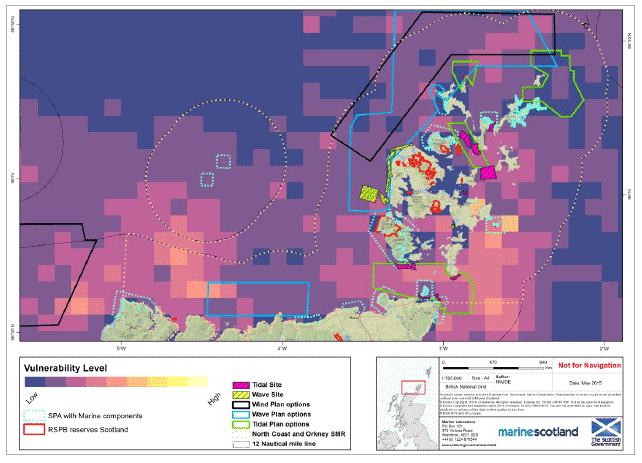
4.10 Commercial fishing
4.10.1 Landings caught by vessels within the Orkney and Scrabster districts had an annual average value of £38 million (9% of the Scottish total) and an average annual live weight of 21,336 tonnes (6.3% of the Scottish total) for the five year period from 2009 to 2013 (Marine Scotland, 2014c).
4.10.2 The main administrative fishing ports in this region are Scrabster and Kirkwall in Orkney. There are also 15 smaller ports throughout the region, (Marine Scotland, 2014c).
4.10.3 Shellfish accounts for the majority of the type of species landings in Orkney with 99.4% of the value and 98.9% of the weight landed into Orkney harbours in 2013. Fishing from pelagic and demersal species accounted for 0.6% of the value landed into Orkney harbours in 2013 and 1.04% by weight. Demersal fishing accounts for the majority of landings into Scrabster by weight and by value. In Scrabster demersal landings represented 74% of the total value landed in 2013 and 75% of the weight landed into that harbour. Shellfish landings into Scrabster represent 26% of the value and 25% of the weight landed that district. Most of these catches will have been taken by vessels smaller than 15 m in length, (Marine Scotland, 2014c) Table 6 shows the number of vessels by size class in the Orkney and Scrabster districts.
4.10.4 There are 593 fishermen employed on Scottish based vessels in these districts around Orkney and the North coast. Of these 442 are based in Orkney and 151 in and around Scrabster and the North Coast. Of these fishermen, in this area 429 are employed full-time and 164 part-time. There are 230 active vessels registered in these combined districts, 177 of which are 10 m and under in length (Marine Scotland, 2014c).
4.10.5 The district of Orkney accounts for 9% of the total catching employment in Scotland. The district of Scrabster accounts for 3% of the catching employment in Scotland. (Marine Scotland, 2014c).
4.10.6 In order to represent the offshore fishing activity (vessels larger than 15 m) as a measure of relative fishing intensity the maps below have been created using Vessel Monitoring System ( VMS) data points. VMS is a form of satellite tracking using transmitters on board fishing vessels. The system is a legal requirement under EC Regulation 2244/2003 and Scottish Statutory Instrument ( SI) 392/2004. Each VMS unit consists of a GPS receiver which plots the position of the vessel coupled with a communications device which reports the position at a minimum of every two hours (Marine Scotland, 2014c).
4.10.7 These maps, Figures 29 to 34, show the relevant fishing types within the PFOW area and have been created by applying kernel density analysis to the VMS data points for each fishing type, for a description of this methodology please see (Kafas et al., 2012).
Table 6. Number of active Scottish based vessels by district and length group as of 31 st December 2013 (Marine Scotland, 2014c)
| Length group (metres) | ||||||||
|---|---|---|---|---|---|---|---|---|
| District | 10m & under |
>10 - 12 | >12 - 15 | >15 - 24 | >24 - 40 | Over 40 |
over 10m | Total |
| Scrabster | 82 | 4 | 2 | 2 | 2 | - | 10 | 92 |
| Orkney | 95 | 25 | 9 | 5 | 4 | - | 43 | 138 |
Figure 29: Fishing intensity ( VMS) for the PFOW crab fishery.
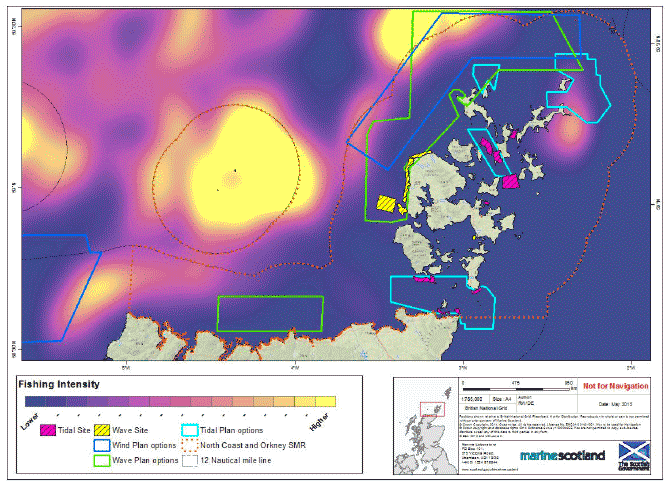
Figure 30: Fishing intensity ( VMS) for the demersal (whitefish) fishery around the PFOW area.
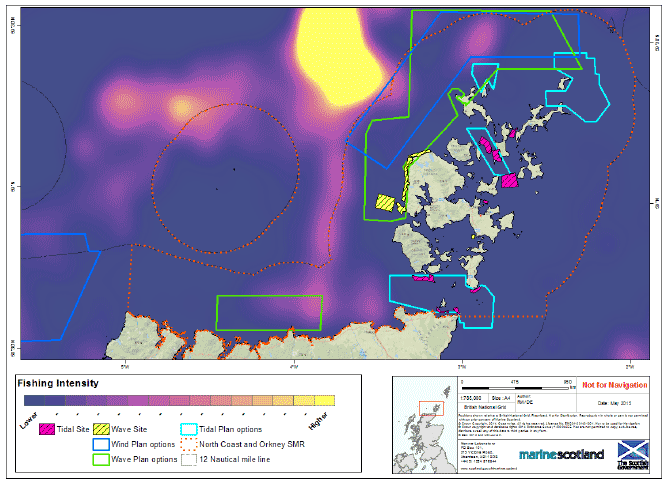
Figure 31: Fishing intensity ( VMS) for the herring fishery around the PFOW area.
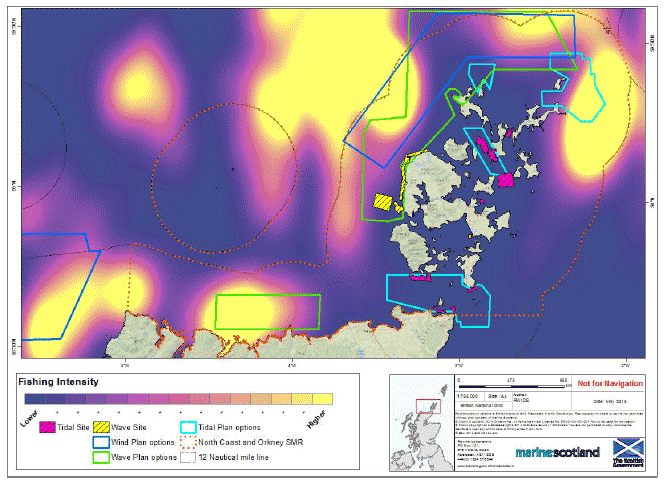
Figure 32: Fishing intensity ( VMS) for the mackerel fishery around the PFOW area.
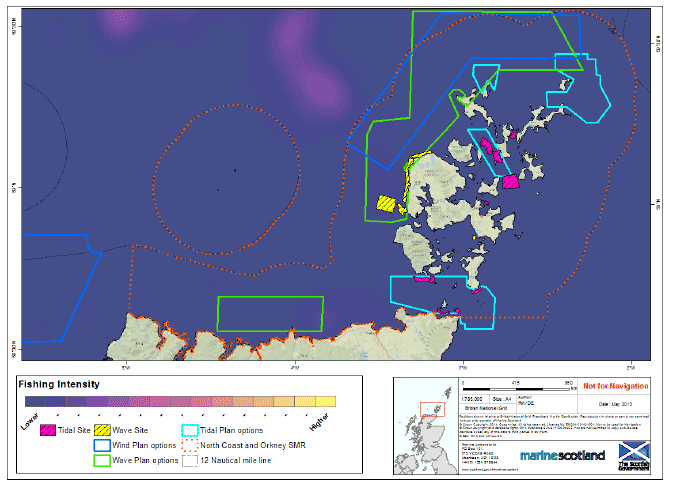
Figure 33: Fishing intensity ( VMS) for the scallop fishery around the PFOW area.
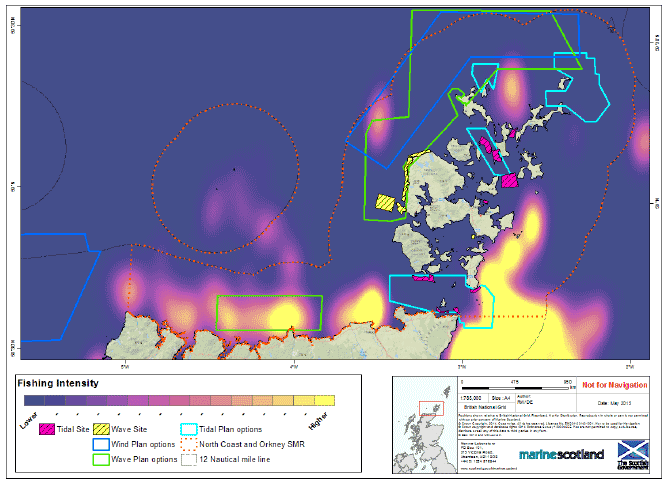
Figure 34: Fishing intensity ( VMS) for the nephrops mobile fishery around the PFOW area.
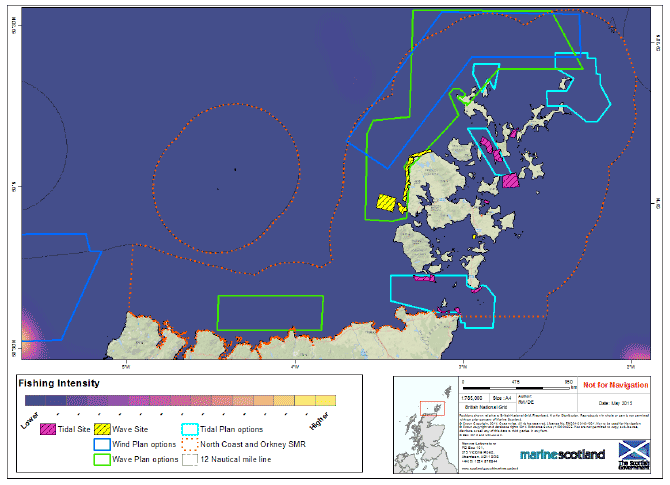
4.10.8 VMS derived data can offer an illustrative depiction of the vessels over 15 m as these are obliged by law to carry this type of transponder. However, currently vessels smaller than 15 m cannot be mapped in the same manner. To solve this the Scotmap project was undertaken to describe spatially the inshore activity of, vessels under 15 m in length, and produce a series of maps representing the absolute value, relative value, number of vessels and number of staff working per vessel. The Scotmap data was derived from information submitted during interviews with fishermen. This took the form of a questionnaire and a GIS plotting session.
4.10.9 The output from Scotmap is shown in Figures 35 to 39, these summarise the main results of the project from areas around Orkney and the Pentland Firth for all the under 15 m vessels for which data was collected. Most of these vessels were creel vessels, although there were small numbers of demersal vessels and scallop dredgers. Scallop divers are also included. A full suite of outputs can be viewed or downloaded from Marine Scotland interactive [23] .
4.10.10 Orkney has one of Europe's largest and most sophisticated crab processing factories, based in Stromness. It is operated by a cooperative, the Orkney Fishermen's Society, with over 75% of local crab fishermen belonging to it and employs 70 people onshore. The new factory, which was built in the mid 90's, initially handled 200 tonnes of crab a year, but it has been extended many times since then and capacity has increased ten-fold (Reid, 2010).
4.10.11 In 2014 the Marine Analytical Unit at MS undertook the task of analysing the value added to the fishery catches in the PFOW waters and the general economic impact of fishing in the PFOW. The report summarises that in 2011, £42.4 million (21,559 tonnes) of marine species were landing into PFOW, £36.8 million from the over 15 m fleet and £6.1 million from the under 15 m fleet. Crustaceans are the key species from the under 15 m vessels whilst demersal species are the target group for over 15 m vessels.
4.10.12 Overall 17% of the value and 16% of volume landed into the region comes from inside PFOW area with 5.6% of the value to over 15m vessels and 90% of the value to under 15 m vessels. This indicates little impact would be felt by the over 15 m fleet, but that under 15 m vessels are more dependent on PFOW area waters (Marine Scotland, 2014d).
4.10.13 Spatially, Scrabster received the bulk of landings (£29.5 million) followed by Kirkwall (£3.8) and Stromness (£3.2). Almost all Orkney ports with the exception of Stromness receive around 50% of their landings from the under 15 m vessels landing crustaceans from inside PFOW area. Northern Highland ports received almost all of the demersal landings and a large volume of crustaceans from over 15 m vessels. Mollusc landings (scallops, whelks) are spread throughout the region (Marine Scotland, 2014d).
4.10.14 Using input-output analysis ( IO) it is estimated that the initial £2.5m of raw material from the PFOW area contributes, directly and indirectly, to £10.4m in output at the local level and £18.4m at the Scottish level. This output supports £2.9m in income and 159 FTE jobs at the local level. At the Scottish level output supports £5.7m in income and 244 full time jobs (Marine Scotland, 2014d) The assumptions applied for this IO analysis are outlined in the cited report.
4.10.15 The results of the Scotmap project can be seen in Figures 35 to 38.
Figure 35: Scotmap, absolute monetary value of fishing from vessels smaller than 15 m length in PFOW.
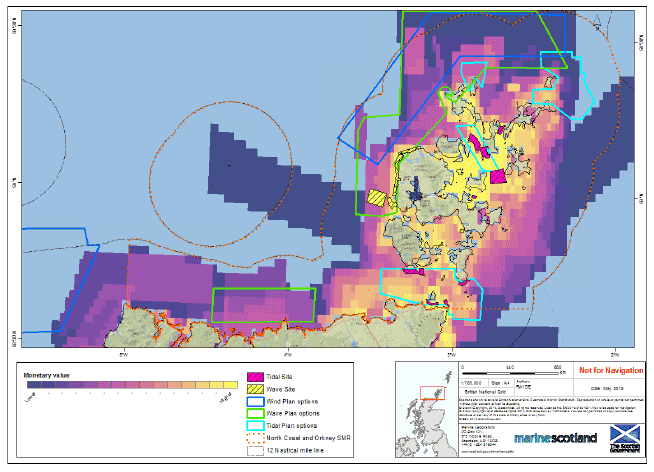
Figure 36: Scotmap, number of crew working in fishing from vessels smaller than 15 m length in PFOW.
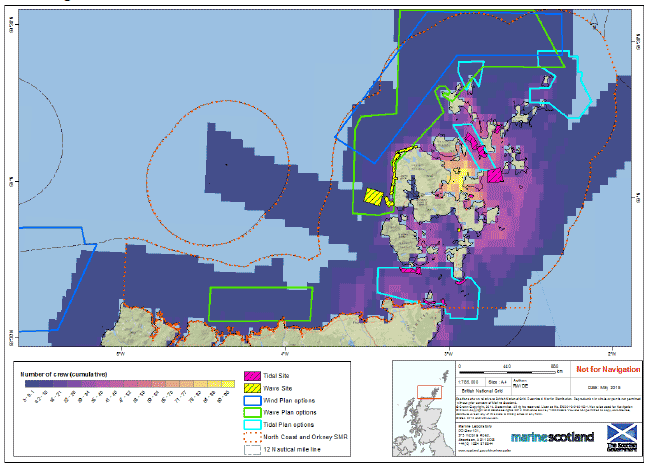
Figure 37: Scotmap, relative value of fishing vessels smaller than 15 m length in PFOW.
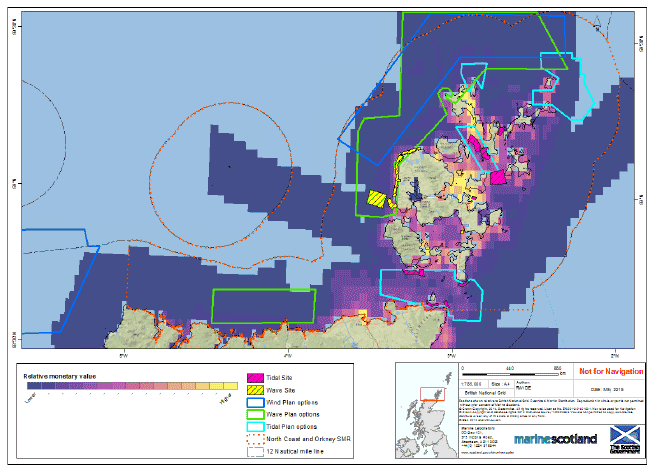
Figure 38: Scotmap, number of fishing vessels smaller than 15 m length in PFOW.
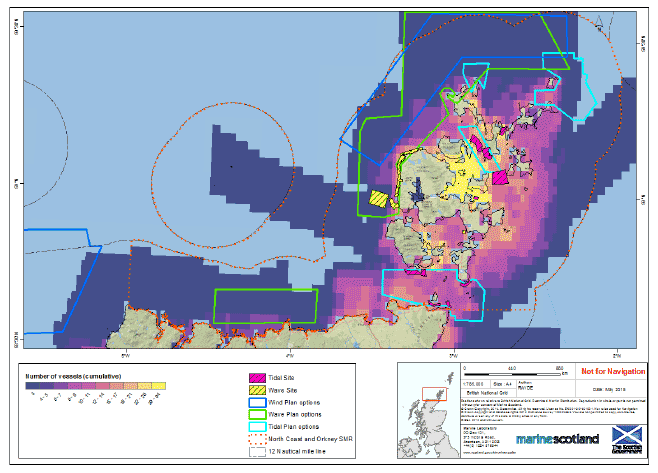
4.11 Wild salmon and sea trout
4.11.1 There is one fixed engine site, located on the North coast near Thurso and Castleton. These sites are south west of TN1 and do not overlap with its extent although it is possible they will have to be considered should any grid infrastructure or installation work begins in this area.
Figure 39: Fresh water fishery activities in the PFOW area.
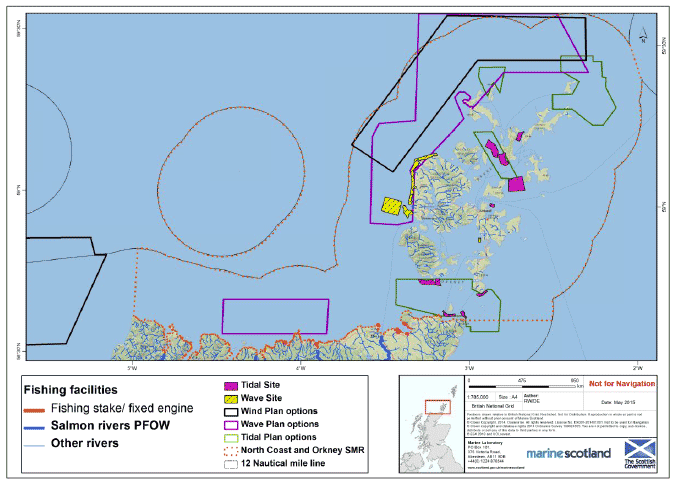
4.11.2 The main rod and line fishing rivers in this region are the Thurso (salmon) Halladale (salmon), Naver (salmon and sea trout), Borgie (salmon), Dionard (salmon and sea trout), Laxford (salmon). Stocks of sea trout have declined dramatically in the Laxford in the last twenty years (Gray, 2009). Figure 39 shows that rivers of importance for this area and the fishing facilities established.
4.12 Landscape designations
4.12.1 Orkney has a National Scenic Area ( NSA) on Hoy and the West Mainland. Its special qualities include its landscape setting for the archaeological World Heritage site, the layering of geology, topography, archaeology and land use as well as the presence of sandstone and flagstone through archaeology and natural exposure (Scottish Natural Heritage, 2010). The coastal scenery is set against the backdrop of constantly changing land and water. Long settled human presence, supported by the productive land and sea, is apparent in the buildings and cultivation of the landscape. Location specific qualities include the high hills of Hoy which form a backdrop to much of the West Mainland, the townscape of Stromness, and the traditional buildings and crofting patterns of Rackwick (Scottish Natural Heritage, 2010).
4.12.2 The Orkney Local Development Plan ( LDP) was published in 2014 and it includes policies that aim to protect the sensitive landscapes within its coastal zone, whilst avoiding frustrating development that requires a coastal location. As a result, Strategic Development areas are identified at Lyness, Billia Croo, Stromness and Houton, to facilitate investment in the marine and renewables sectors. Further information is available from the Orkney Islands Council website [24] .
4.12.3 The key characteristics of the Local Landscape Area of Denwick and Mull Head include the high, eroded cliffs and range of seabirds and plant communities. The area of Mull Head is also noted for its wild qualities. East Holm to Weddell, Burray is notable for the man-made features of the Churchill Barriers, and the Italian Chapel. The landscape is a significant element of the experience when crossing the barriers, which is undertaken by many visitors to Orkney. Ignaness Bay is noted for its sandy bays with intervening rocky coastline and low cliffs, and two brackish lochs are found at Swarsquoy. St Peter's Pool and Dingieshowe comprises the unusual geomorphology of a shingle ayre, areas of sandy beach, dunes, bay and sand flats, and exposed cliffs (Visit Scotland, 2014a).
4.12.4 The Kyle of Tongue National Scenic Area is located on the Northern Highland Coastline. Its special qualities include its rich variety of coastal scenery, its role in linking an inhabited coast to a wild moorland, and the constantly changing character of the Kyle (Scottish Natural Heritage, 2010).
4.12.5 The Highland Council has identified 5 special landscape areas along the Northern Highland Coast, see Figure 40:
- Oldshoremore, Cape Wrath and Durness: This extends along the coastline from Cape Wrath in the west to Durness in the east. The coastal character of the area (including bays, inter-tidal areas cliffs and dunes) and its sense of remoteness and extremity are key parts of its special qualities (Scottish Natural Heritage, 2010).
- Eriboll East and Whiten Head: On the north coast of Sutherland. This area's cliffscapes, open coastal waters and sheltered loch (including the eastern shore of Loch Eriboll) are key features. Remoteness is also a key part of the area's special qualities (Scottish Natural Heritage, 2010).
- Farr Bay, Strathy and Portskerra: This extends from Bettyhill to Melvich, and includes moorland and crofting areas. The area's coastline, rocky headlands, sheltered bays are all key features. Views to the sea and along the coast are also recognised as important parts of the area's special qualities (Scottish Natural Heritage, 2010).
- Dunnet Head: This area covers the Dunnet Head Peninsula and Dunnet Bay, the most northerly point of mainland Britain. The prominent headland and cliffs, and relationship between land and sea are all key features. Views to Orkney and along the northern coast are also essential components (Scottish Natural Heritage, 2010).
- Duncansby Head. This lies to the east of John o'Groats, and includes Duncansby Head and the Stacks of Duncansby. This area's cliffs and its northerly character are essential components of its special qualities (Scottish Natural Heritage, 2010).
4.12.6 Scottish Natural Heritage provides a Landscape Character Assessment ( LCA) for all of Scotland's regions [25] , these can be seen in Figure 41.The diversity of landscapes of Scotland in the PFOW area are identified. This mapping project highlights what it is that gives familiar areas their distinctiveness and identity and suggests what might attract people to explore new areas; and should help instil a desire to ensure that the diversity of Scotland's landscapes is not diminished [26] .
Figure 40: Landscape designations in the PFOW area.
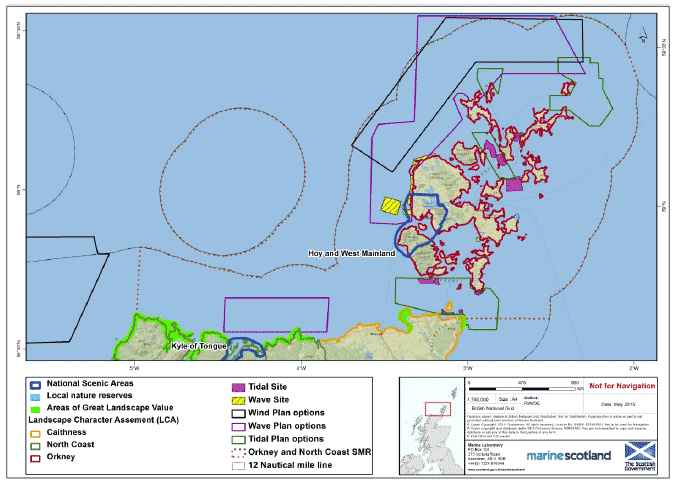
Figure 41: Landscape characteristic types in the PFOW area.
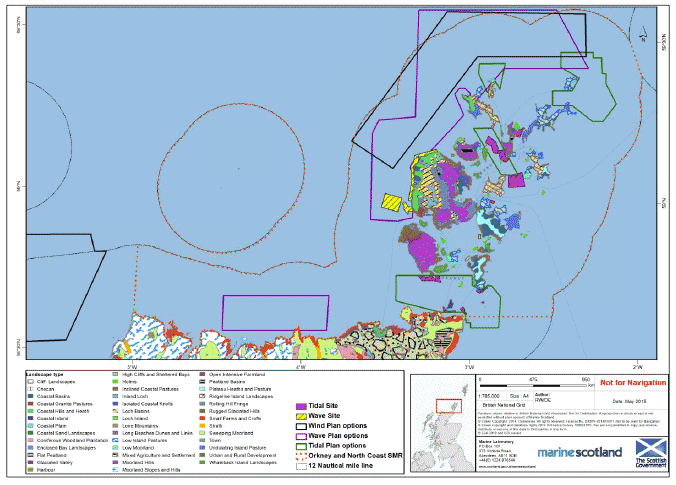
4.13 Geological designations
4.13.1 Figure 42 shows the geological designations in the North Region. Although these features are on land they could potentially be affected by renewable developments and will have to be taken into consideration.
4.13.2 Geological designations in the PFOW area include Geological Conservation Review ( GCR) sites. There are 15 GCR sites on Orkney and many more on the North Coast of Scotland. More details of GCR sites can be found at the JNCC website ( JNCC, 2014b).
4.13.3 Figure 42 shows the aggregate resource locations available around PFOW. OWN1, WN2 and a fraction of TN3 overlap with this resource which is mostly fine sand. This information has been provided by the Crown Estate and can be readily downloaded [27] .
Figure 42: Sediment resources in the PFOW area.
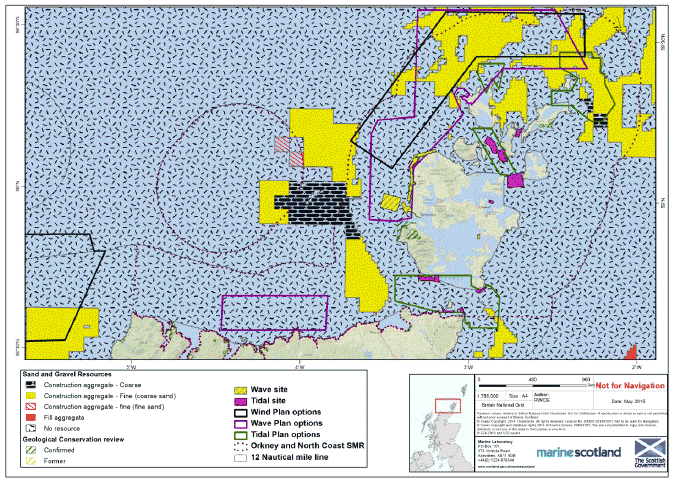
4.14 Infrastructure and Grid Provision
Existing infrastructure
4.14.1 The North does not host any major power stations. Dounreay nuclear power station, the one major power generator in the area, closed in 1994. It is currently being decommissioned, the completion date for this is estimated at 2022-2025 [28] .
4.14.2 Figure 42 shows the infrastructure in the region, including submarine cables and pipelines. Numerous domestic subsea power cables exist in this region.
4.14.3 The potential infrastructure and grid provision within the PFOW area includes:
- Developments in Pentland Firth that connect into Dounreay
- Developments at Orkney that connect to Dounreay via the reinforced Orkney subsea cable
- Table 7 provides an indication of the current stage of the planning for the potential infrastructure projects. Future developments in grid infrastructure will be included into further iterations of the Plan.
Table 7. Current stage of planning for potential infrastructure projects (North region).
| Orkney-Caithness Link | The proposed Orkney-Caithness link will connect to the current Dounreay substation in Caithness. A new Bay of Skaill substation has been proposed to be built on the west coast of Orkney. Allowances have been made for the further expansion of the Proposed Bay of Skaill Substation if the Wave and Tidal Generators on the West Coast of Orkney are developed successfully. The SHE Transmission Orkney-Caithness proposal includes:
In February 2014 SSE published a stakeholder consultation seeking views on the options for reinforcing the electricity network on Orkney. The Consultation response showed that 63% of respondents supported the development of a new distribution link and 71% in favour of developing either a distribution link, a transmission link or both (Scottish and Southern Energy, 2014). |
|---|
Figure 43: Existing subsea cables and substations in the PFOW area.
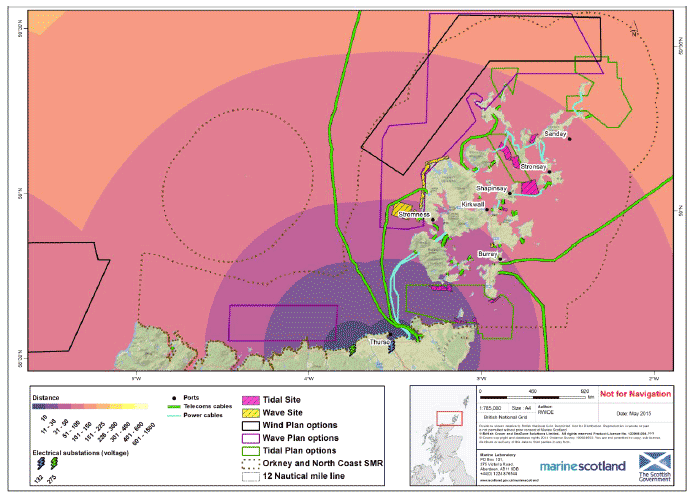
Oil and gas
4.14.4 In this region, Oil and Gas activity is concentrated in offshore waters to the East of the Orkney Islands.
4.14.5 Oil and Gas activities in the PFOW area include a terminal on Flotta, and an associated pipeline running west from the Flotta Oil Terminal. There are no producing hydrocarbon fields in the PFOW area. The known oil and gas infrastructure in the region are shown in Figure 44.
4.14.6 The nearest hydrocarbon fields to the region are the Captain field (approximately 99 Km south-east of the Flotta Oil Terminal), the Lybster Field (approximately 64 Km south of the Flotta Oil Terminal) and the Beatrice and Jackie Fields (approximately 76 Km south of the Flotta Oil Terminal).
4.14.7 Shipping traffic associated with oil and gas activity in the PFOW area is significant. During the 56 day survey period of a Marine Scotland shipping study (Marine Scotland, 2012b) 145 unique tankers were recorded within the strategic area. Most of the traffic was associated with transit through the Pentland Firth. Six unique tankers called at ports within the PFOW area (at Scrabster, Kirkwall, Flotta Oil Terminal, and Scapa Bay).
4.14.8 Information on the processing capacity of the Flotta Oil Terminal is provided by DECC. Estimates of the total receipt of crude oil into the Flotta terminal 733 thousand tonnes in 2013 and 372.203 million tonnes since the terminal started processing ( DECC, 2014). Gas processing statistics are not allocated to terminals so it is not possible to estimate gas processing at the Flotta Oil Terminal ( DECC, 2014).
4.14.9 There are currently two fixed platforms in Scapa Flow.
Figure 44: Oil and Gas industry features in the PFOW area.
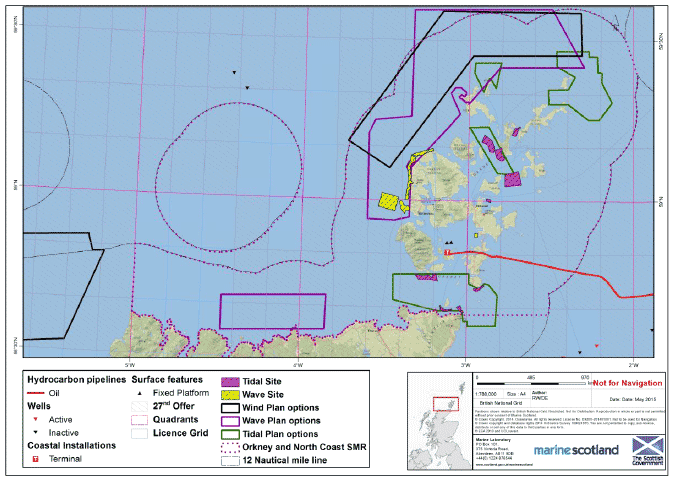
Local Development Plans
4.14.10 The Proposed Orkney Local Development Plan ( LDP) was published in 2011 and work continues on it, with a number of milestones completed and currently underway. This plan recognises the importance of renewable energy development in tackling climate change and achieving economic growth. It includes policies that aim to protect the sensitive landscapes within its coastal zone, whilst avoiding frustrating development that requires a coastal location. As a result, Strategic Development areas are identified at Lyness, Billia Croo, Stromness and Houton, to facilitate investment in the marine and renewables sectors. Constrained areas are also identified, to help steer renewable energy developments towards areas where there is greater capacity. Broad Areas of Search are set out in Supplementary Guidance, which take into account a range of constraints. The proposed LDP also states that Supplementary guidance will be produced to address onshore infrastructure requirements arising from marine renewable energy developments, and the need for improved grid connections.
4.14.11 Policy SD7 of the proposed LDP provides a decision making framework for renewable energy developments. This aims to achieve development, where significant adverse environmental effects can be avoided or appropriately mitigated.
4.14.12 The 'Caithness and Sutherland Local Development Plan - Main Issues Report' (Highland council, 2014) recognises and values the growth in the renewable energy industry in the PFOW area. It acknowledges the importance this sector has in providing viable economic employment for local people. The report suggests that suitable sites for the onshore elements of offshore renewable developments should be identified, with land allocations to support these uses. It is also proposed that the Highland wide Local Development Plan should contain a policy that specifically supports the marine renewables industry.
Ports and harbours
4.14.13 On Orkney, Hatston (Kirkwall) and Lyness on Orkney are included within the Low Carbon / Renewables North Enterprise Area. They have also been identified as key sites to support the wave and tidal sectors, for further consideration in N-RIP Phase 2. NorthLink Ferries uses both Kirkwall to connect to the more northern Shetland Isles and Stromness and as a port for the mainland ferry. The opening of deep water facilities at the adjacent Hatston extended the scope for Kirkwall to service a range of larger craft including cruise ships. This is a key centre for both fishing and leisure activities. Hatston is already linked into the renewables sector, and used by developers involved in the European Marine Energy Centre ( EMEC). Further development of the port is already underway.
4.14.14 Lyness is the port for the ferry from the Mainland to Hoy. It is a key economic investment area, identified to support assembly, storage and servicing of renewable energy devices. A development brief has been prepared to guide the planning and investment planned around Lyness Harbour and the wider peninsula. Improvements will be made to the moorings, new buildings are planned and extensive areas of hard standing will be laid.
4.14.15 On the mainland Scrabster is a key port, identified for further consideration in Phase 2 of the N-RIP. Its location on the Pentland Firth is focusing plans for improvement and investment, to support the wave and tidal renewables sectors. Redevelopment is ongoing. Wick has also been identified as a key potential location to support wave and tidal related activities in Phase 2 of N-RIP.
4.14.16 In addition to the four large ports in this region, a further 42 ports and harbours are located in four distinct areas: mainland Scotland, the Orkney Island, Fair Isle and the Shetland Islands. Many of these ports provide important facilities, quays, jetties and shelter for offshore vessels moving between port locations and the offshore oil, gas and renewable industry in Scottish waters.
Table 8. Ports and Harbours in the North Region
| Port | Operator | Type | ||
|---|---|---|---|---|
| Balfour | Local Authority | |||
| Birsay | Barony Hotel - Birsay | Private | ||
| Brough | Private | |||
| Burray | Local Authority | |||
| Castlehill | Private | |||
| Deerness | Deerness Small Boat Owners Association | Private | ||
| Eday | Local Authority | |||
| Holm | Local Authority | |||
| Hoy | Local Authority | |||
| John O'Groats | Local Authority | |||
| Kirkwall | Orkney Islands | Local Authority | ||
| Sanday | Orkney Islands Council | Local Authority | ||
| Scapa Flow | Orkney Islands | Local Authority | ||
| Scarfskerry | Local Authority | |||
| Scrabster | Scrabster Harbour Trust | Trust | ||
| South Ronaldsay | Local Authority | |||
| Stroma | Local Authority | |||
| Stromness | Orkney Islands | Local Authority | ||
| Stronsay | Local Authority | |||
| Thurso | Local Authority | |||
| Tingwall | Local Authority | |||
| Westray | Local Authority | |||
4.14.17 Ports within this region contribute to the local and the regional economy as employers, and through the provision of essential services and facilities as lifeline services for ferries, and berths for fishing vessels other than the cargo tonnages detailed for Orkney. Other ports providing input to the local economy include Scrabster Harbour which has an annual reported economic output of £39m, supporting 339 full time jobs and contributing a Gross Value Added ( GVA) impact of £14.6 million to Caithness. Scrabster Harbour handles a gross tonnage in 2007 of 9.85Mt. The port also has a significant trade in shellfish and demersal fish. The port also accommodates lifeline ferry service links to the Orkney Isles with 149,000 passenger and 46,000 vehicles. The port hosts international ferry services and cruise liner calls with some 6,294 passengers and 2,000 vehicles handled in 2007, returning an estimated £4m for the Highland economy (Scrabster Harbour Trust, 2008).
Recreational angling
4.15.1 The main launch spots for charter based angling are Thurso in North Scotland and Stromness on Orkney (Radford, et al., 2009). Wreck angling is popular in Scapa Flow and also on other wrecks found offshore from Orkney. Cod, pollock and mackerel, are the most popular target species in Caithness and Sutherland. There is some evidence, however, of sports fishing for rarer species such as porbeagle shark becoming more popular. In Orkney conger eel is found amongst the wrecks of Scapa Flow and is the most popular target species, followed by mackerel and bass (Radford, et al., 2009).
4.15.2 A study by Radford et al. (2009) estimated the sea angling activity and economic value in eight regions of Scotland. Parts of two of these regions, 'North Scotland' and 'Orkney and Shetland' contain the PFOW area . As the areas in Radford et al. (2009) do not align completely with the North Region the values should only be taken as indicative values for comparison between areas laid out in Radford et al. (2009). The total estimated regional sea angling activity and expenditure within these two regions is £11.2m in the North and £6.1m in Orkney and Shetland (Radford, et al., 2009). In terms of employment, angling accounts for around 300 employees in Northern Scotland and a further 145 in Orkney and Shetland (Radford, et al., 2009). Figure 45 shows the known recreation locations around the PFOW area.
Figure 45: Sea-based recreation in the PFOW area.
Recreational boating
4.15.3 Marine Scotland, commissioned a study of shipping activity to better inform the pilot Marine Spatial Plan for the Pentland Firth and Orkney Waters Area. The aim of the process was to ensure improved knowledge of the use of these waters by all stakeholders so that future developments do not inadvertently impact on important existing activities. Given that this is the most up to date source on this activity in the PFOW area it is the main data source for this section of the report. The study itself combined literature review of existing spatial data (Admiralty charts, Royal Yachting Association ( RYA) Atlas) with key stakeholder consultation as shipping density data generated from AIS collected transmissions (Marine Scotland, 2012b).
4.15.4 The study also provided data on Commercial Shipping and Recreational Vessel activity, including yachts (cruising and racing), power boats, motor cruisers, recreational and sports fishing ( e.g. sea angling), wildlife cruises and recreational diving, etc.
4.15.5 The consultation can be distilled into the following conclusions taken from Marine Scotland (2012b).
- All of the PFOW area is important to recreational users with individual areas of importance dependent on the specific user group.
- The vast majority of recreational activity takes place throughout the summer months (April to October) for all stakeholders. Examples of all-year round activity include limited sailing, kayaking and leisure fishing.
- Club-orientated activities are the most regular occurring on a weekly basis. Less frequent sailing trips occur on an annual or bi-annual basis.
- Consideration of tide and weather conditions is imperative due to the strong nature of tides in the PFOW area with certain passages not possible in certain tidal states or weather conditions.
- Few resident recreational vessels in the area are equipped with AIS. More commonly it is better equipped visiting yachts that have AIS installed.
- The RYA Coastal Atlas provides a good foundation for characterising recreational shipping [29] .
- Indicative routes do not tell the full story as individual recreational sailors like freedom to go where they please, and routes are already very variable due to tides and weather.
- Kayakers are a separate, unique group that have similarities to yacht sailors but would need a separate study to fully characterise their behaviour. No kayaks carry AIS and therefore a more in depth study is required to fully understand the most commonly used routes.
- Kayakers exhibit different behaviours to other recreational users. Routes taken often hug the coastline. As kayakers are not limited by depth, they are able to make use of areas other recreational users cannot. Kayakers value bays with suitable launching sites with greater importance compared to conventional marinas and anchorages.
4.15.6 The density of recreational shipping in the summertime is summarised in Figure 46. This figure shows the amount of recreational vessels that use the PFOW waters. However, it must be borne in mind that only one in six of these vessels carry AIS transponders and that these are the predominantly the larger vessels (Marine Scotland, 2012b). This map also shows the location of anchorages used by recreational vessels.
4.15.7 The highest density of recreational shipping occurs between island, with particular density between Mainland and Hoy or between Mainland and Rousay. Tidal POs TN1 and TN2 as well as the southern part of TN4 have the most dense recreational traffic overlapping them (Marine Scotland, 2012b).
4.15.8 The consultation with stakeholders revealed that RYA cruising routes were more informative when expressed as lanes rather than lines. Figure 47 shows the resulting map.
4.15.9 Figure 47 shows that the Tidal PO in the Pentland Firth area ( TN1) is crossed by recreational shipping lanes as are TN2, TN3 and TN4 as also crossed by recreational shipping lanes.
4.15.10 Wave PO WN1 is also crossed by several recreational lanes as is WN2 mostly on its eastern side.
Figure 46: Density of recreational vessels in PFOW.
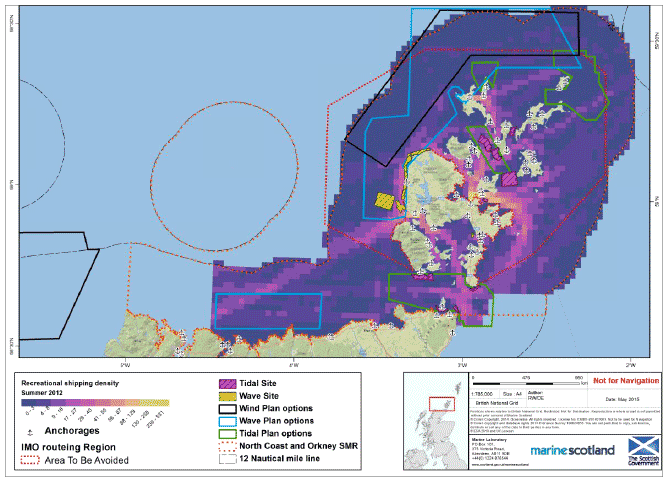
Figure 47: Location and extent of recreational sailing in the PFOW area.
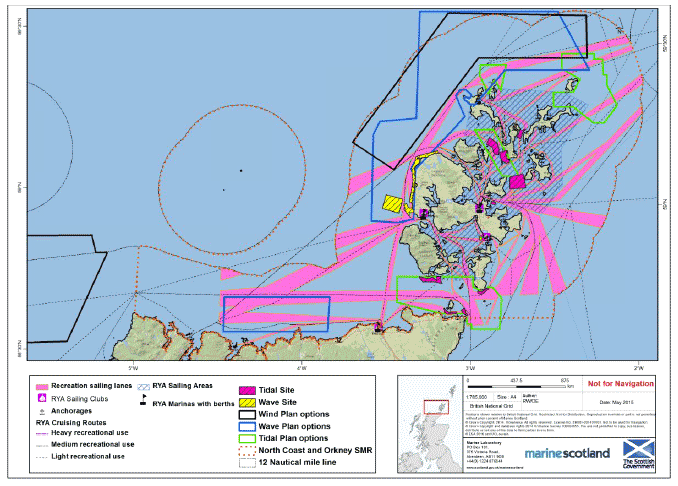
4.15.11 There are a number of dive boats based in Orkney that are chartered for recreational diving, as well as occasional sea angling and sightseeing trips. Dive boats spend the majority of their time visiting wreck sites in Scapa Flow (Marine Scotland, 2012b).
Scuba diving
4.15.12 The most popular area for scuba diving in the region is around Scapa Flow in Orkney .This body of water is considered one of the finest wreck diving sites in Europe is highly regarded among the wreck diving areas of the world (Jackson, 2008; Baxter, et al., 2011). While scuba diving has predominantly been based in Scapa Flow historically, it increasingly involves diving in other parts of Orkney (Jackson, 2008; Visit Orkney, 2009). Recreational diving is predominantly charter based with an estimated 3,000 visiting divers annually (The Orkney Hyperbaric Trust, 2008). A limited amount of diving is also undertaken on the mainland in this region.
4.15.13 The Orkney Hyperbaric Trust was set up to increase diver safety within Orkney waters. Diving is an important industry in this region and is estimated to be worth at least £3m a year to the Orkney economy (The Orkney Hyperbaric Trust, 2008). The diving industry consists of military and police, commercial and archaeological and recreational, the latter accounting for approximately 25,000 of the dives made each year which are carried out from two dive boats, who take around 3,000 visiting divers/year, to dive sites such as the Scapa Flow area.
Sea kayaking and small sailing boat activity
4.15.14 Dinghy sailing clubs are located in Kirkwall, Stromness, and Westray in Orkney and Scrabster on the North Coast ( Figure 47).
4.15.15 There are two yole sailing clubs [30] on the Orkney Islands (Marine Scotland, 2012b). A yole is a traditional boat made of overlapping wood planks that can be rigged for sailing or used as rowing boats [31] .
4.15.16 In terms of popularity, kayaking around Orkney and the North coast of Scotland is not considered as important as other regions such as the Inner Hebrides and East Grampian Coast (Land Use Consultants, 2007).
Surfing and wind surfing
4.15.17 Some of the UK's best surfing breaks are situated along the North coast of Scotland. The region receives strong, powerful swells and provides a number of high-quality surfing spots. In particular, the reefs situated around Brims Ness and Thurso are considered to be world-class (Surfers Against Sewage, 2009). Orkney also has good quality surfing locations although participant numbers are less than on mainland North Scotland, primarily due to accessibility (Surfers Against Sewage, 2010). The location of surfing breaks in the North area can be seen in Table 10 and Figure 45.
4.15.18 Windsurfing on Orkney is a popular activity at Kirkwall's Scapa Beach and Orphir's Waulkmill Bay. In addition, the storm beach of Skaill Bay on the West coast of mainland Orkney and Sandwick, are popular spots (Visit Orkney, 2009).
Table 9 Popular surfing locations in the PFOW
| General Location | Surf Location |
|---|---|
| Sutherland | Melvich |
| Strathy | |
| Armadale Bay | |
| Farr Bay | |
| Torrisdale | |
| Kyle of Tongue | |
| Sandwood Bay | |
| Point of Ness | |
| Dunnet Bay | |
| Castlehill to Murkle | |
| Murkle Point | |
| Thurso East | |
| Pipe | |
| Brimms Ness - The Point | |
| Brimms Ness - The Cove | |
| Brimms Ness - The Bowl | |
| Sandside Bay | |
| Caithness | Gills Bay |
| Brunt Skerries | |
| Harrow Harbour | |
| Scarfskerry Reefs | |
| Ham | |
| Orkney | Marwick |
| Skail Bay Right | |
| Skara Brae |
(Source: Based on Surfers Against Sewage, 2009 [32] and 'Stormrider Guides', 2010 [33] and Windsurf Magazine 'Beach Guide', 2011 [34] ).
4.16 Shipping
4.16.1 This section also refers to the PFOW shipping study (Marine Scotland, 2012b) as the most up to date and complete information source.
4.16.2 Various analyses by vessel type were done for this study. The area which sees the highest density overall is the Pentland Firth which will have to be considered in the context of tidal PO TN1. This density of shipping traffic is composed of vessels with a variety of draughts. The maximum draught recorded in vessels that have been recorded crossing the Pentland Firth is of 25.5 m, however this vessel mostly functions as an offshore Oil exploration installation and is not a regular component of the traffic. Only a small amount of vessels exceed 10 m of draught. Only two of these have been tracked within the Orkney Islands and are associated with the Flotta Oil and Gas terminal (Marine Scotland, 2012b).
4.16.3 There were more deep-draught vessels transiting the Pentland during the summer period than the winter period, Marine Scotland, 2012. The mean draught for winter and summer is of 4.9 m The most common category was 4-6 m, comprising 36% of vessels in winter and 30% of vessels in the summer period, (Marine Scotland, 2012b).
4.16.4 There is a heavy traffic of smaller, shallower draught vessels that overlap PO TN2 at Rousay Sound. By type the vessels that will overlap the most with the POs are cargo, passenger and cruise vessels.
4.16.5 Figure 48 shows the mean density for summer and winter for the year 2012 for all vessels over 300 Gross Tonnage ( GT). Indicative ferry routes have been added but it must be borne in mind that ferry routeing can change depending on the wind and the tidal activity as well as and other shipping traffic safety issues. This means that no one single line can be mapped out to define the likely route of the ferries and a large transit area has to be considered.
4.16.6 In the shipping study forty-one unique passenger vessels were tracked in the Pentland Firth and Orkney Waters Strategic Area during the combined survey period. These were both passenger vessels and cruise ships. Fifteen vessels were regular passenger ships. Four of these operated between the Scottish Mainland and Orkney. These were Pentland Ferries' Pentalina (operating between Gills Bay and St Margaret's Hope) and Serco NorthLink's Hamnavoe (Scrabster to Stromness) and Hjaltland and Hrossey (serving the Aberdeen/ Kirkwall/ Lerwick route). Eight were inter-island ferries operated by Orkney Island Council.Three were vessels transporting personnel between the Flotta Marine Oil Terminal and Flotta, Lyness, and Houton, (Marine Scotland 2012b).
4.16.7 The most heavily overlapped POs by ferry movements are TN1 and TN2. The large area covered by TN1 is crossed by two of the ferries that make daily trips between the Scottish mainland and the Orkney Island. Between the Pentalina and the Hamnavoe and Hjatland over 200 crossings were made in the month of January 2012. Further north, TN2 is crossed regularly by the Earl Thorfinn over a large extent of the area of this PO.
4.16.8 The ferries that have regular interaction with the tidal POs in Orkney have draughts of: Pentalina 2.2 m, Hamnavoe 4.4 m, Hjaltland 5.4 m.
4.16.9 The wind and wave POs do not overlap with ferry traffic.
4.16.10 One Marine Environmentally High Risk Area ( MEHRA) has been established on the western coast of Hoy, this MEHRA was put in place to due to high abundances of sensitive such as: fulmars, puffins, guillemots and razorbills. Landscape and geological designations also contribute to this site's classification as a MEHRA. Ships navigating close to a MEHRA should do so with a high level of care or avoid passing close to these locations in the first instance.
4.16.11 The shipping density component of the study's data were extractions of Automatic Identification System ( AIS) data for the PFOW area. Regulation 19 of the Safety of Life at Sea ( SOLAS) requires AIS to be fitted aboard all ships of 300 gross tonnage and upwards engaged on international voyages, cargo ships of 500 gross tonnage and upwards not engaged on international voyages, and passenger ships irrespective of size built on or after 1 July 2002 (Marine Scotland, 2012b).
4.16.12 Fish farm traffic is also busy within and around the Orkney Isles may also be affected by the offshore developments.
Figure 48: Mean shipping density in winter and summer in the PFOW area.
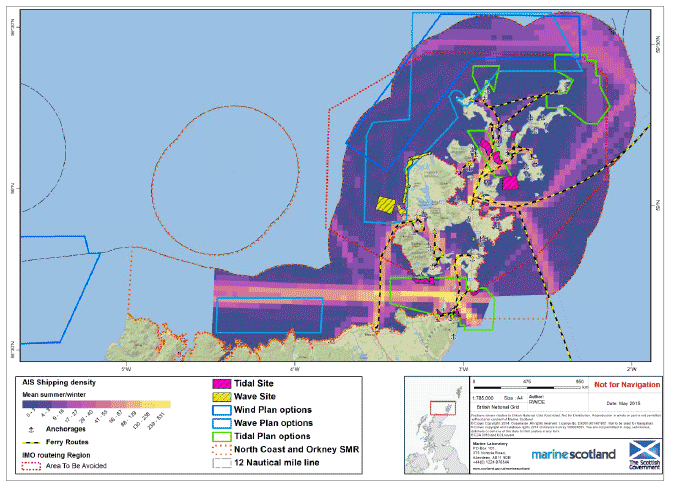
4.17 Social considerations
4.17.1 A Socio-economic baseline review was carried out for approximately this area (ABPMer, 2012). Although the North Region outlined in the baseline doesn't align precisely with the PFOW (as it includes Shetland), the data reported in the baseline can give an indication of social considerations in the PFOW area such as economic, employment and health status of the area and its inhabitants.
4.17.2 The total population in North Region in 2012 was 41,000, it being much more sparsely populated than other regions. The overall average age in the North Region was 40 years old (one year greater than the national average). The working age population declined from a peak of 35,700 in 1996 to around 34,300 in 2002, after which it has levelled off. In 2010, the working age population was 34,500, and the overall change (1996 to 2010) is a reduction of 3.2%. The population of children has declined across the whole period (from 12,700 in 1996 to 10,300 in 2010, equivalent to a reduction of 18.5%) while the number of people of pensionable age has increased by 29.7% (from 9,800 in 1996 to 12,800 in 2010) (ABPMer, 2012).
4.17.3 Average income in 2009 was lower than the national average for the Orkney Islands. The greatest number of jobs are associated with human health and social work activities (20% of the total for 2010). Other industry sectors accounting for more than 10% of jobs are public administration and defence; compulsory social security at 15%, wholesale and retail at 12%, and education at 10%. Agriculture, forestry and fishing and arts, entertainment and recreation both make up around 3% of all jobs in the North (ABPMer, 2012).
4.17.4 Crofting is an important part of the economy and community in Orkney. The Orkney area contains 466 crofts with 8035 households in parishes containing crofts. Crofting makes up a relatively high percentage of household income in Orkney (47.3%),. Average total income in Orkney was £20,240 in 2007 (Hilliam, 2007) and income from crofting activities is high in the Orkney Islands (£12,800) (ABPMer 2012).
4.17.5 The proportion of people rating their health as good or very good in the Orkney Islands increased from 89.9% (2001/2002) to 90.1% (2007/2008) (ABPMer, 2012).
4.17.6 There are 612 coastal datazones for the Scottish Index of Multiple Deprivation ( SIMD) in the North, with 78% of all datazones being coastal. In 2011 none of the datazones in the PFOW area (coastal or all) fell into the 10% most deprived areas. There is no difference in percentage that are in the most affluent decile for income or housing between all and coastal datazones however, there is an increase to 10% (from 8%) of coastal zones being in the most affluent decile for employment, and from 5% to 6% for health. These statistics suggest that communities in the PFOW are more likely to be affluent (in the wider sense of quality of life), although only a small proportion of datazones fall into the most affluent 10% (ABPMer, 2012).
4.17.7 There has been an increase in the population with no qualifications within this region. The Orkney Islands has the highest proportion of the population with no qualifications in both 2004 (9.9%) and 2008 (11%). The minimum drive time to a college of Further or Higher Education in the Orkney Islands was 77 minutes in 2012 (ABPMer, 2012).
4.17.8 House prices for both the Orkney are below the national average. In 2010, the national average was £154,078 while the average in the Orkney Islands was £114,153 (26% lower than the national average). Average earnings in Orkney (2009) were around 7% lower than the national average, though, due to the lower average house price, affordability in the Orkney Islands may also be greater than for Scotland as a whole (ABPMer, 2012).
4.17.9 The highest perceived quality of life in 2007/2008 was in the Orkney Islands, where 77.9% rated their neighbourhood as good or very good. The Orkney local authority area has shown an increase of 15.8% (since 1999/2000) in the percentage of the population rating their neighbourhood as very good or good (ABPMer, 2012).
4.17.10 Average electricity consumption (per household) in the North Region was 10.4 MWh in 2009 (compared with an overall estimated average per household for Scotland of 5.7 MWh). Those households where the highest income earner ( HIH) is 60+ are more likely to be in fuel poverty than the whole population in 2007/2009. At 63.9%, this is much higher than the national average of 45.9% for this group. The percentage of HIH 60+ in fuel poverty has, though, decreased between 2005/2008 and 2007/2009. The proportion of households with HIH 60+ that were in fuel poverty (at the time of the report) in the Orkney Islands was 64.4%. There has been a reduction in the proportion of population in fuel poverty in the Orkney Islands of -11.3% between 2005/2008 and 2007/2009.
4.18 Supply chain
4.18.1 There are a number of ports within the Region which support the Pentland Firth and Orkney Waters commercial leasing round for wave and tidal energy projects.
4.18.2 The N-RIP Stage 2 Report also includes the following ports in the Region which initial assessments suggest may be suitable locations to develop wave and tidal supply chain activities:
- Lyness
- Hatston (Kirkwall)
- Scrabster
- Wick
4.18.3 The Pentland Firth and Orkney Waters area has recently been classified as a Marine Energy Park. The purpose of the park is to heighten the international profile of the region and its reputation as a world leader in marine energy. The park builds on collaborative partnerships in the region between government on the main land and the Orkney Islands, Highlands and Islands Enterprise ( HIE), plus a cluster of local expertise and renewable resource in the area, in order to heighten the progress of marine power development.
4.18.4 Based in Orkney, EMEC Ltd is the first and only centre of its kind in the world to provide developers of both wave and tidal energy converters - technologies that generate electricity by harnessing the power of waves and tidal streams - with purpose-built, accredited testing facilities. The centre has 14 full-scale test berths, and two nursery test sites where smaller scale devices, or those at an earlier stage in their development, can gain real sea experience in less challenging conditions than those experienced at the full-scale wave and tidal test sites.
4.18.5 Beyond device testing, EMEC also provide independently-verified performance assessments, a wide range of consultancy and research services, and are working closely with Marine Scotland to streamline the consenting process. Further information is available at the official EMEC website [35] .
4.18.6 In addition to EMEC, there are a number of firms operating in the region with offer consultancy services in relation to the development of wave and tidal energy. More information can be found at the HIE website [36] .
4.18.7 There are established oil and gas supply chain activities taking place within the region. It is therefore likely that skills in areas such as in marine engineering, operations, maintenance and bespoke manufacturing which are already established, will be suitable for application in the wave and tidal energy sectors.
4.18.8 Energy North is a trade organisation that focuses on the Energy sector and covers the north east region. It covers the North of Scotland and Argyll areas currently has 211 members from the oil and gas, renewables, engineering, fabrication and nuclear decommissioning sectors.
4.18.9 In terms of educational facilities, there is the International Centre for Island Technology ( ICIT) - Heriot Watt in Orkney, which provides MSc courses in renewable energy [37] . Students will be able to see first hand the application of the course content given the many activities related to this field in and around Orkney.
4.19 Tourism
4.19.1 Tourist sites in North Scotland include a range of attractions, with a considerable concentration of general tourist attractions on Orkney see Figure 44 in section 4.15 Marine Scotland have commissioned study in 2014/15 to assess the spatial extent and associated socio-economic value of marine and coastal tourism and recreation in Scotland. This will include a major case study focusing on the Pentland Firth and Orkney Waters. Results from this study will be included into future iterations of this Plan.
4.19.2 Historic/heritage attractions and natural heritage attractions also feature in significant numbers on Orkney. The Heart of Neolithic Orkney was designated as a World Heritage Site in 1999 and includes the tomb of Maeshowe, the Stones of Stenness, the Barnhouse Stone, the Watchstone, the Ring of Brodgar and associated monuments and stone settings, and the Skara Brae settlement.
4.19.3 Within the PFOW area, there are additionally several areas with seaside awards by Keep Scotland Beautiful [38] (see Figure 44 in section 4.15 ) These include Sango Sands, Strathy Bay and Melvich Beach along the North coast. There are also designated bathing waters at Thurso and Dunnet. The importance of natural marine resources is also illustrated by this region having three marine SACs, at Sanday, Faray and Holm of Faray and Loch of Stenness.
4.19.4 While visitor numbers for the whole region are not readily available, it was possible to obtain data for Orkney from Visit Scotland. Data for 2012-2013 indicate that visitors made around 142,000 trips to Orkney, and spent approximately £31 million (Visit Scotland, 2013).
4.19.5 Orkney's cruise ship industry generates almost £3.1m (€3.7m, or £3.083m [39] ) for the local economy each year, according to a recent survey [40] according to the Orkney Island's Council website. The article goes on to reveal that 95% of those surveyed said it was their first visit to Orkney and indicates that each cruise passenger spends on average around £46 (€55) while ashore, with crews spending just over £8.30 (€10). Across the 73 cruise ship visits in 2013, the total spend by passengers and crew, while ashore or on tours in the county, was reported at £2.25m and £61.6k respectively. Discounting spending on pre-arranged and self-arranged tours, the estimated spend on the 'high street' by passengers and crews was €1.035m (£0.8m). The top categories of spending by passengers were crafts and souvenirs (51.3%), restaurants and bars (44.4%) and clothing (20.8%). All information taken from Orkney Island's Council website [41] .
4.19.6 Whale and wildlife watching activities are also popular with tourists in the PFOW area and there are a number of organized boat trips in the North Coast and Orkney given the many marine mammals that can be spotted [42] .
4.19.7 In 2010, HIE carried out market research to identify what would potentially trigger sector and business growth for the region of Caithness and North Sutherland. As a result, the report 'A Framework for Destination Development' has been produced. The report is available at the HIE website [43] .
4.19.8 Estimates put the expected visitor numbers enjoying tourism activities in the Caithness and Sutherland area to increase by 30% over the next ten years. The study takes into account the impact of the decommissioning of Dounreay, the growth of renewables for business tourism, the redevelopment of John o' Groats and the expected increase of domestic and international visitors [44] .
4.19.9 Existing tourist attractions and activities around this area include museums like Caithness Horizons in Thurso, archaeological sites -Caithness has huge numbers of archaeological sites and almost all of them have not been seriously investigated by digs [45] , the Caithness archaeological trust at Dunbeath can provide guidance for the historically minded tourist. Also many heritage centres can be found that provide focal points for the rich culture of the area [46] . Distilleries like the Pulteney distillery in Wick shows off one of Scotland's finest and well known products.
Contact
There is a problem
Thanks for your feedback